Bambu Lab P1P Review, Specs, Price & Photos: Bambu Lab made a splash in the global 3D printing community with the X1. We were able to convince ourselves that this hype is justified in the reader test of the Bambu Lab X1 Carbon (Combo). A shortcoming was and is the price, which only starts at well over 1000€. Bambu Lab now surprises with the Bambu Lab P1P for the equivalent of ~795€ for pre-order. How does the P1P fare in our test?
Bambu Lab P1P Review, Specs, Price, Photos, Videos
- Bambu Lab P1P 3D printer
- Specifications: X1 in cheaper
| printing technology | FDM (Direct Drive) |
| print speed | 500mm/s (!) |
| acceleration values | 20000mm/s² |
| installation space | 256x256x256 [mm] |
| print bed | heatable (up to 100 degrees) |
| max. nozzle temperature | 300 degrees |
| nozzle diameter | 0.4mm (optional 0.2, 0.6, 0.8) |
| flow rate | 332 mm³/s |
| connectivity | microSD, Wi-Fi, Bluetooth, App, PC software (proprietary) |
| features | auto leveling2.7 inch display with button500mm/sAutomatic Material System (AMS) (4 colors) [optional]Installation space heating up to 60°C (indirectly via heating bed, with self-made panels)Component cooler in the build space (12W) (optional)Humidity sensor (optional)Filament distance measurement (optional)720p camera (optional)Power Loss RecoveryVibration Compensation (Automatic) & Pressure Advance |
| Dimensions | Weight | 386 x 389 x 458mm | 9.65kg |
Who is Who: Who is Bambu Lab P1P?
The headline could also mean: Why is Thommy over the moon? Well, because Bambu Lab, a Chinese newcomer to the 3D printer market founded by former DJI engineers, has just released a low-cost version of the super-fast, successful X1 model much faster than expected. Mind you, low-cost still means just under €800.
Many parts of the X1 can also be found in the Bambu Lab P1P, which was made available to us for testing without further conditions. This test – I have to warn you – will be very long and detailed, because Bambu Lab is basically creating its own complete ecosystem here, which I cannot and do not want to leave out.
Design: More individuality, more DIY
Bambu Lab P1P Review promises a setup of just 15 minutes to the first print. You have to do without side panels, instead Bambu Lab promises to be able to customize the black aluminum CoreXY printer with steel chassis.
How? With the help of 3MF print files provided free of charge for all panels that should be accessible at market launch. So you can decide for yourself from a total of 10 design templates whether you prefer the “tool look” (hole grid wall for hanging tools), a “flowing flame” (flaming flowers in a dot design) or the design “lily” (flowers in the “engraved look”).
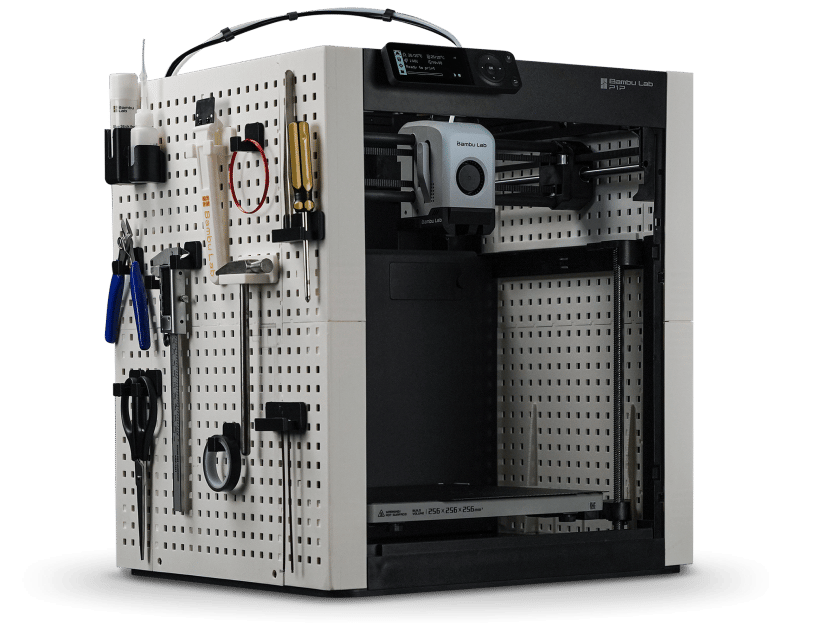

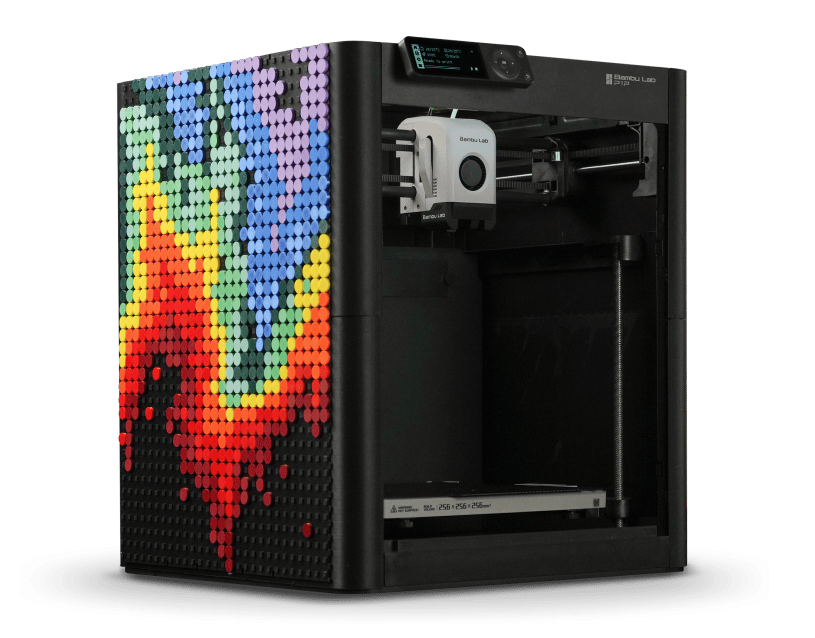
At the time of this test, we received the designs “Armor”, “Bambu Lab Edition”, “Lily”, “Pegboard” and “Pixel” – but also: our own CG logo – awesome!
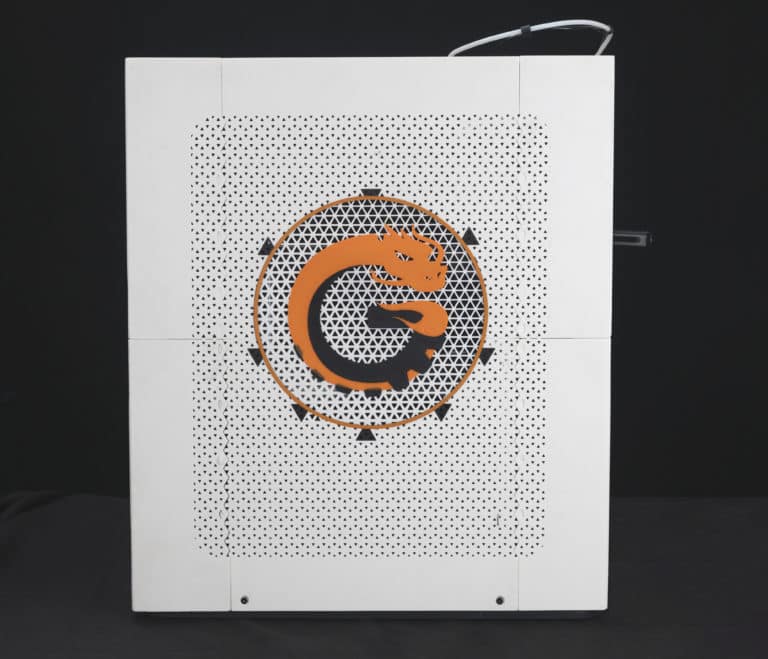
Incidentally, Bambu Lab basically opts for 3mf files because, in contrast to the STL files that are also supported, these contain not only the 3D model, but also its orientation, support structures and printing parameters. For beginners in particular, this means much greater convenience and a faster route to the first successfully printed object.
The DIY approach is also reflected in the possible manufacturer upgrades . We have a printable holder for the optional LED strip, holder adapter for the AMS (Automatic Material System) and “fan support” for the optional 12W installation space component cooler in digital form.
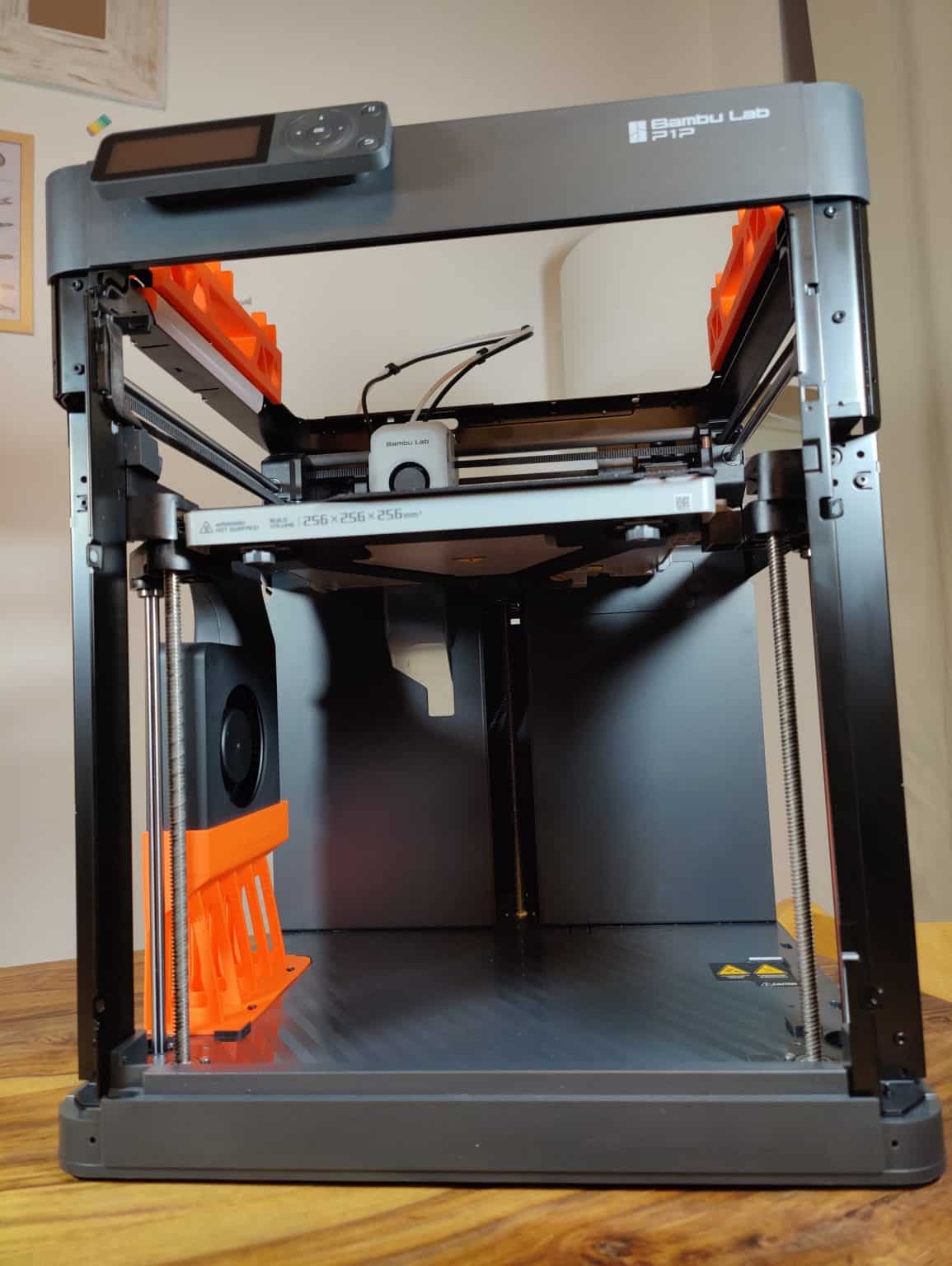
Background to the latter: With the Bambu Lab X1 Carbon, users often had the problem of a component cooler detaching from the side wall over time. Appropriate fan support structures (Fan Support) for it were soon available on Thingiverse and Printables. Bambu Lab is therefore also including a 3mf file of the specially designed fan support for us.
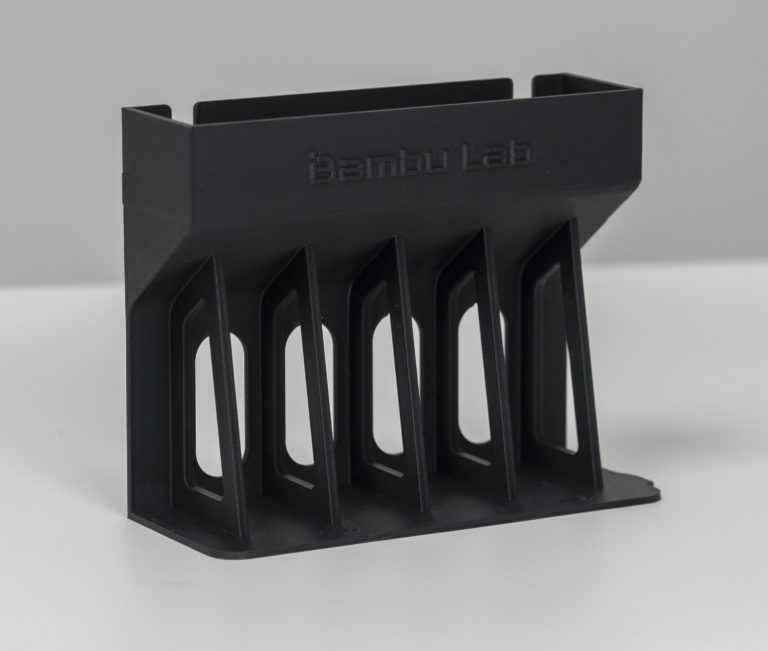
Also really great: There are (at least for us) 3mf and step files from the P1P chassis available. While there are no holes/holes there, it makes it easier for me to design for further upgrades – what are they? Keep checking this article and you’ll see. With this approach, hobbyists also get their money’s worth – at least as far as case modding is concerned. Because the system itself is and remains proprietary.
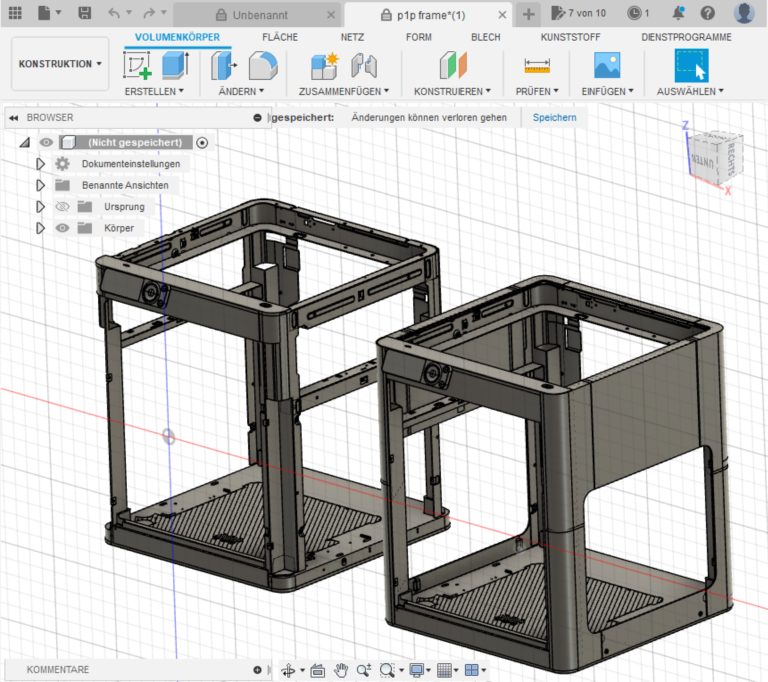
Packaging & scope of delivery: well thought out
- Christmas anticipation
We have two packages in the typical shade of brown with little labeling under our Christmas tree: we received the P1P and an AMS from Bambu Lab , which will of course also be used for multi-color prints.
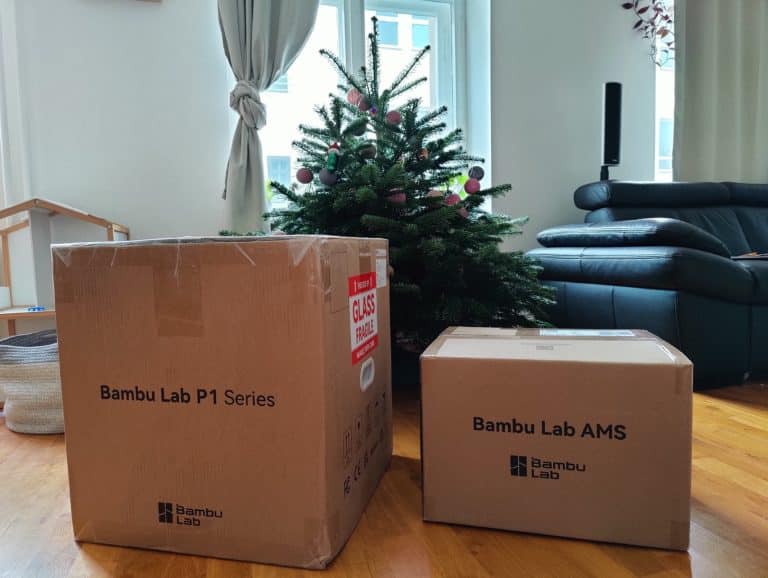
What exactly is in it?
First impression: everything is very compact – both the Bambu Lab P1P and its packaging. There are 4 components in the whole box:
First of all, of course, the printer, which is conveniently wrapped in a plastic bag in such a way that you can simply pull it out of the box at two ends of the bag. A Quick Start Guide is glued to the top for the purpose of freeing all transport locks.
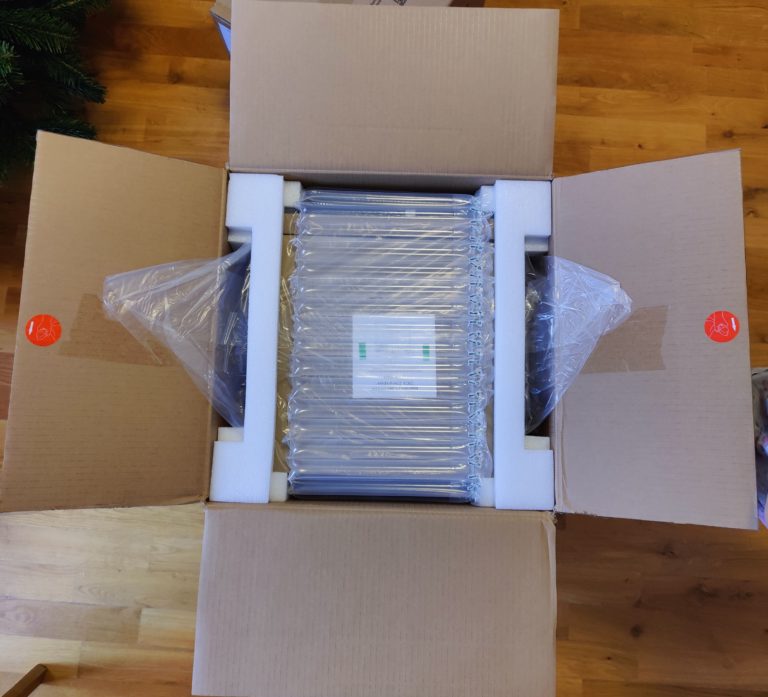
The second package with all kinds of utensils can be seen in the printer’s installation space: the first thing I notice here is 1 kg of Bambu PLA Basic Filament and a replacement PTFE tube. In addition to a Disclaimer & Safety Guide, there is also a glue stick (60ml) for a rock-solid hold on the structured PEI print surface.
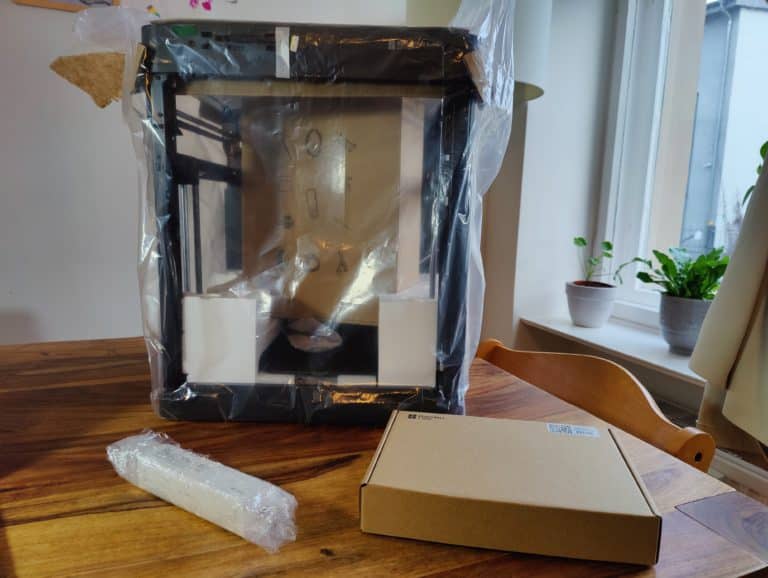
The latter probably has the strongest magnetic function that I have experienced so far. It is coated on both sides and labeled identically “PLA, ABS, TPU, PC” – with the reference to not being suitable for the X1’s LIDAR system.
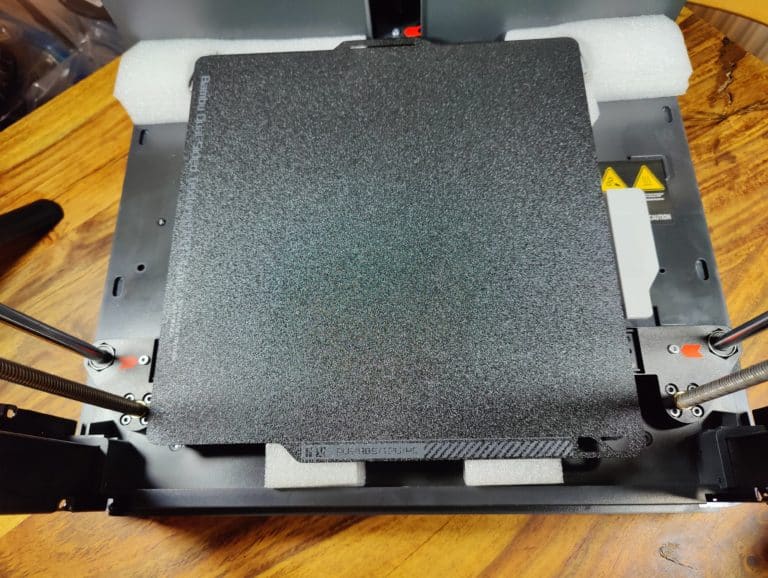
Glue sticks for the housing to be printed out, along with the LED strip that we have, are also included in the package – just like the blade of a spatula , the handle of which Bambu Lab has ready, like all other printable upgrades, as a 3mf file on the micro SD card .
A PTFE connection piece, a replacement hotend including a replacement nozzle , 2 replacement filament strippers, various screw packages with exemplary labeling, 2 Allen keys and a needle for cleaning a clogged nozzle are also included.
Not seen before: two small packets of grease and thermal paste. Finally, there is the filament holder, which is installed on the back of the printer after loosening a screw there.
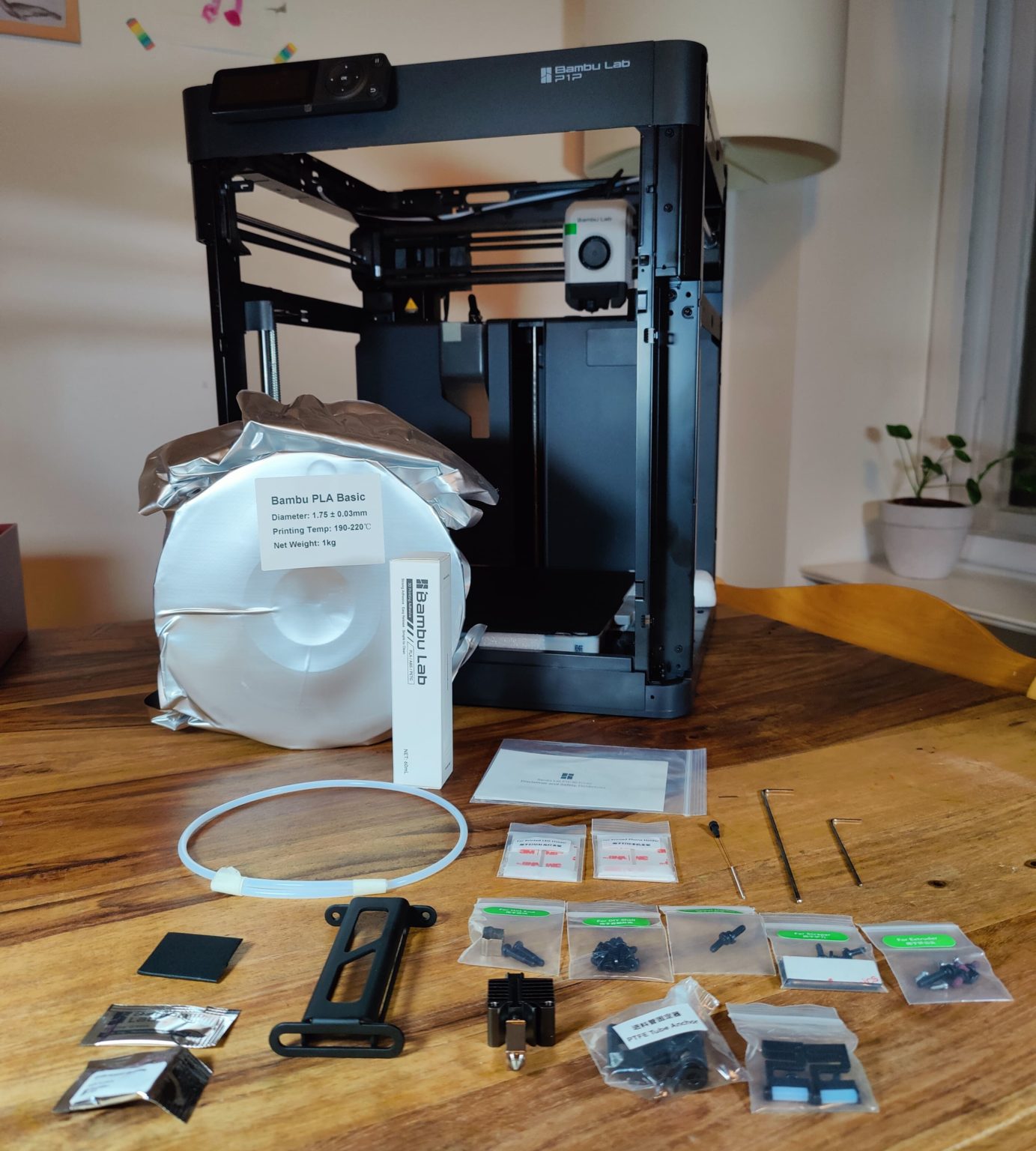
Upgrade Box
At the bottom of the big box: A small box with a QR code that provides a video for building the contents of the box: 720p camera, 12W build space component cooler, screws and a build space LED bar. I had already announced these upgrades several times in the context of the associated 3mf files, and now I can see them live.
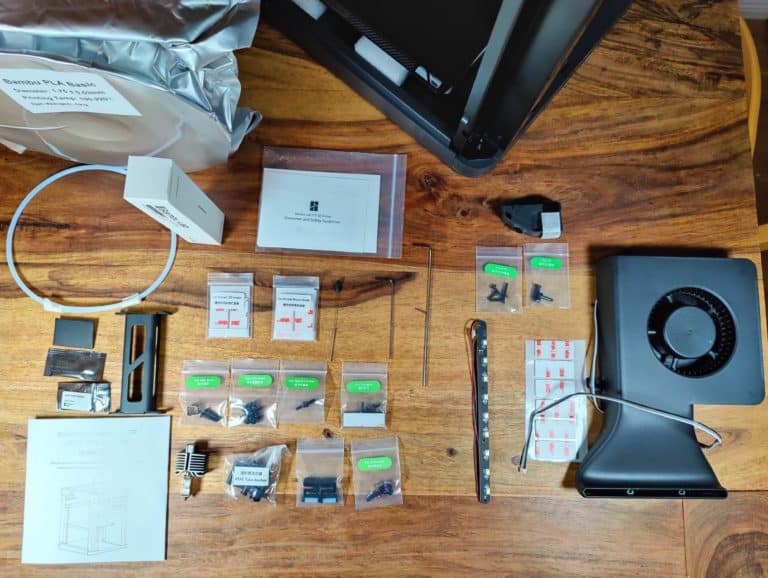
AMS
The second box under the Christmas tree contains Bambu Labs optional AMS. If you unpack it, the system appears including 4 reusable bamboo filament spools. There is also a small, brown box and a small white zip-lock bag containing the PTFE hoses along with the PTFE connection piece, warranty and safety information and the quick start guide.
In the said brown box, on the other hand, there is a 4-pin and a 6-pin cable with bamboo bus connection, 2 replacement filament cutters, a PTFE hose connector and a filament buffer. The latter later serves on the back of the P1P to buffer the respective filament and to guarantee a certain filament tension necessary for the extruder above the print head.
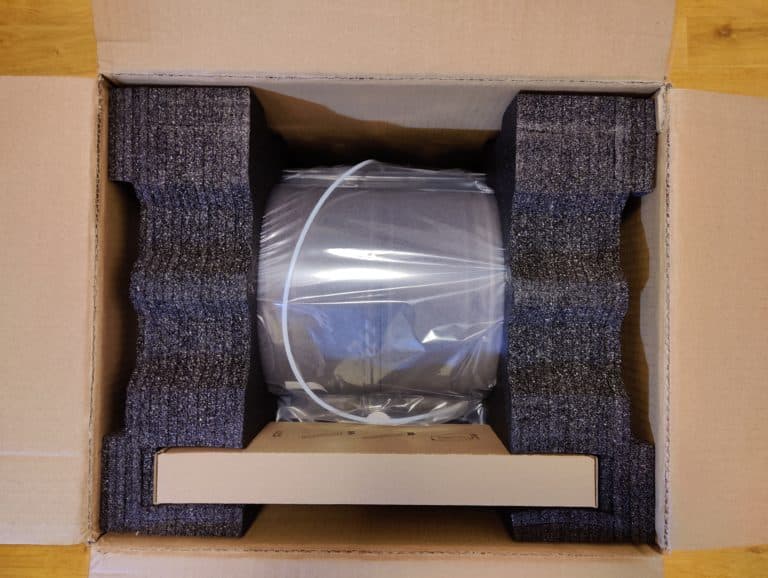
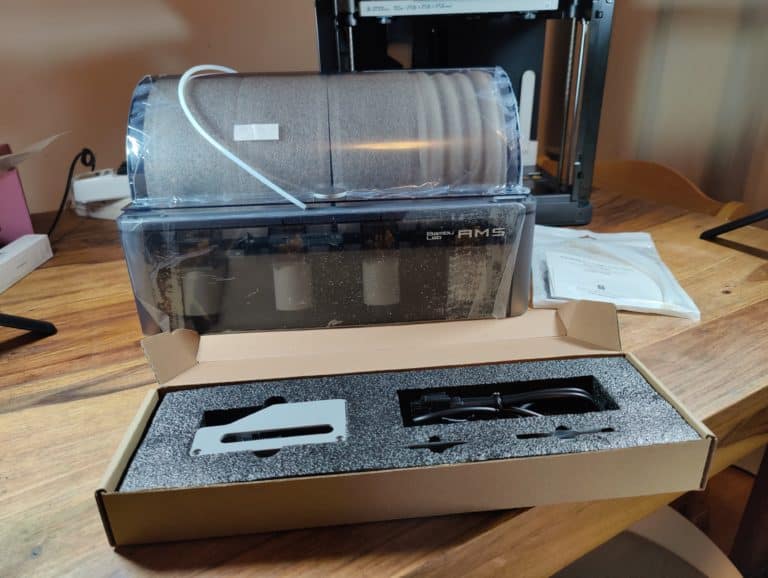
Design: industrial style
- Looks
At first glance, the Bambu Lab P1P seems inconspicuous and surprisingly compact , considering that it is a 500mm/s fast CoreXY device with a 300-degree hotend and an idiosyncratic installation space of 256 x 256 x 256mm. The black metal chassis is characterized by all sorts of recesses and screw holes, which, with a little imagination, make it clear that this is a Bambu Lab X1 that has been “blank” so to speak.
Bambu Lab P1P Review / One could declare this design as an industrial look or simply see it as the result of a red pencil cure. In any case, an “unfinished” visual impression cannot be completely dismissed. Bambu Lab undoubtedly sees the user’s duty here, who will probably only give the P1P its final – and indeed individual – appearance after printing its own side panels and other external modifications.

Connections
Bambu Lab P1P Review / In addition to a micro SD slot, Wi.Fi, Bluetooth and the bamboo bus on the back of the printer are also on board . The latter finds its purpose for connecting the AMS. Otherwise connections are hidden. For example, a circuit board on the inside of the front upper cross brace is covered with tape, where there are a few 3- and 4-pin sockets, which are intended for connecting the optional LED light, in addition to a ribbon cable connection for the optional 720p camera . However, if you screw the lid on the backof the device, then there are other connections such as the one called “FAN 2” for the optional 12W installation space component cooler.
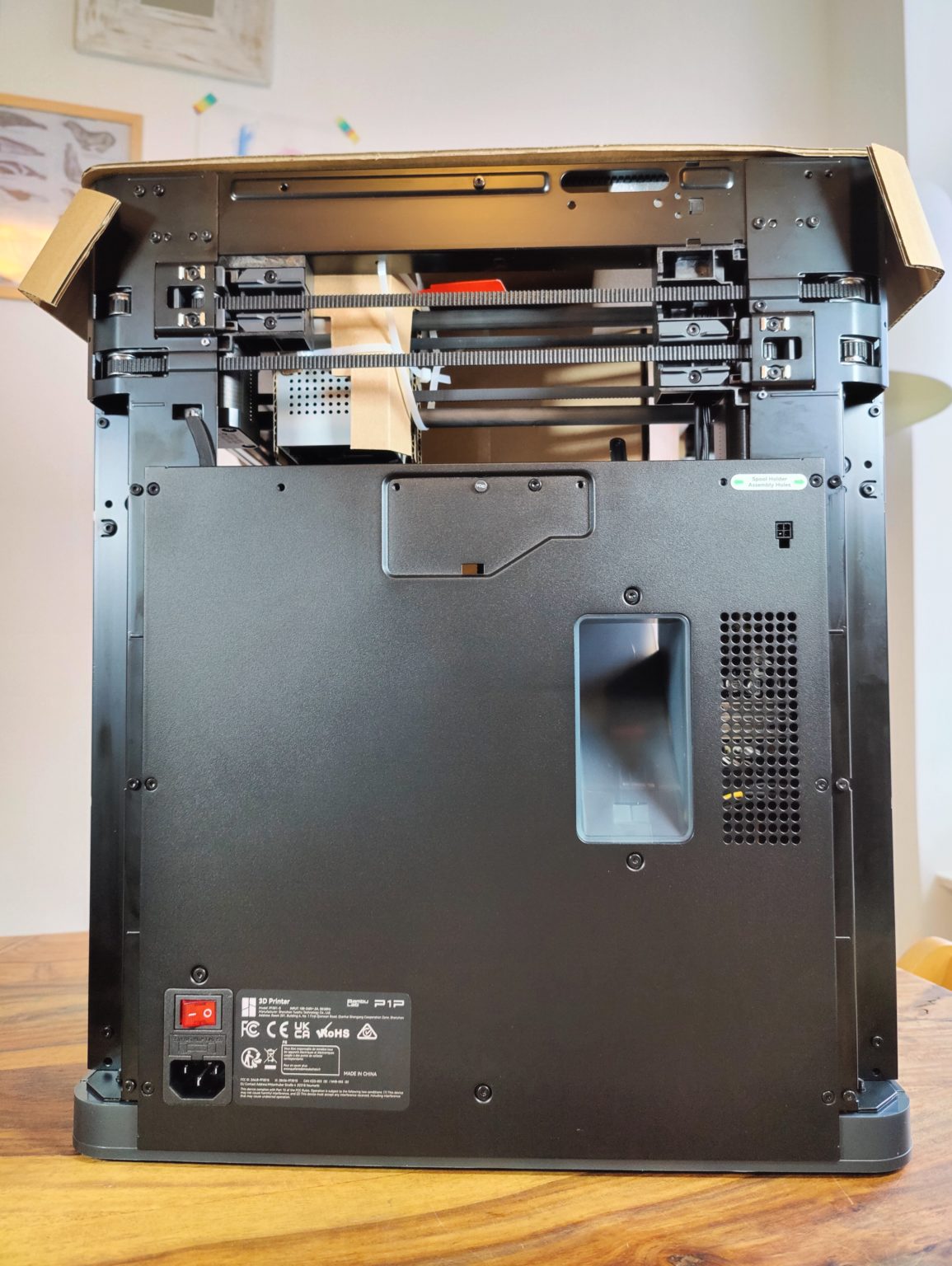
Build Quality & Construction: Deluxe
Bambu Lab P1P Review / The build quality of the Bambu Lab P1P is flawless. Nothing wobbles, everything is well thought out and all components are of high quality. In short: not only the price is premium here, the content is definitely too.
The setup is quick and easy. If I didn’t hammer these lines into the laptop at the same time, I would probably be done in 20, no 30 minutes. 15 minutes is a bit ambitious, but experience has shown that the manufacturers always outdo each other with the shortest possible setup.
So remove a few transport screws (nicely marked with red arrows), connect the small 2.7-inch display to a connector and clip it in, mount the filament holder and then the PTFE connection piece, insert the PTFE tube into the print head and into the connection piece, finally peel off various foils (aaah, always an intimate moment).
When installing the optional 72op camera, I scan the included QR code for an installation video, but I get to the Bambu Lab wiki page, where the wiki for the P1P is still under construction – not publicly available. My friend Google helps and lo and behold, I discover an installation video for the Bambu Lab X1:
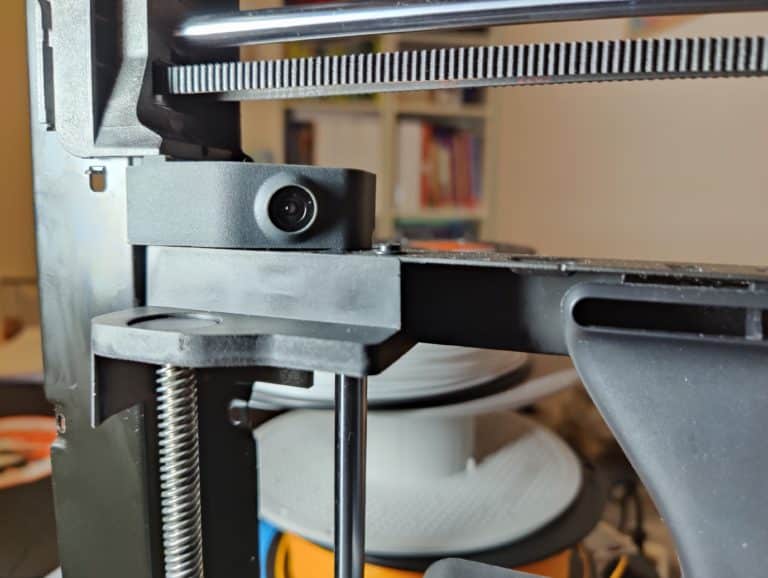
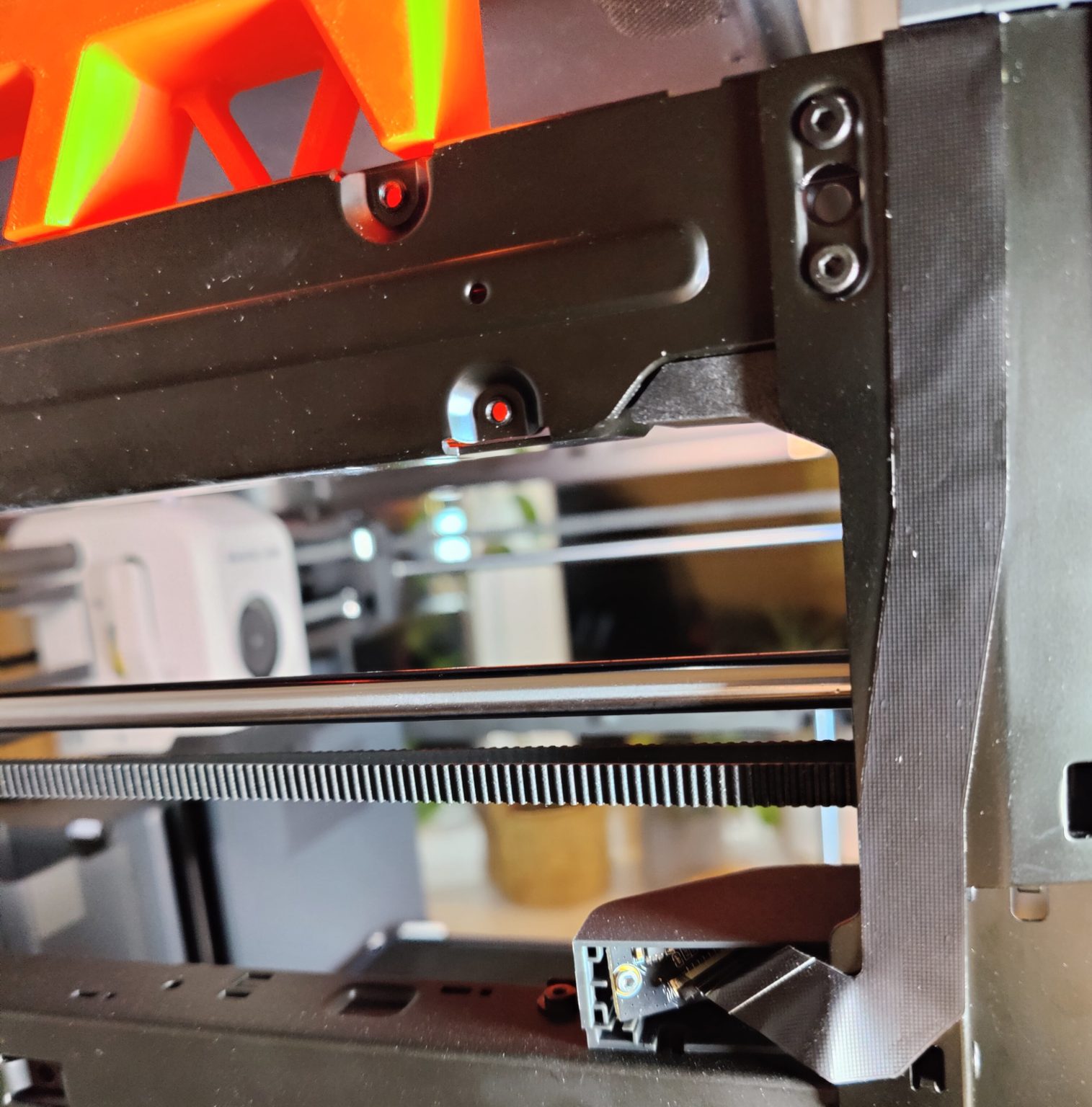
What I keep noticing when setting it up: Bambu Lab pays attention to little things that make 3D printing life easier: There is a magnetically held print head cover to quickly get to the hotend nozzle combination and fans inside.
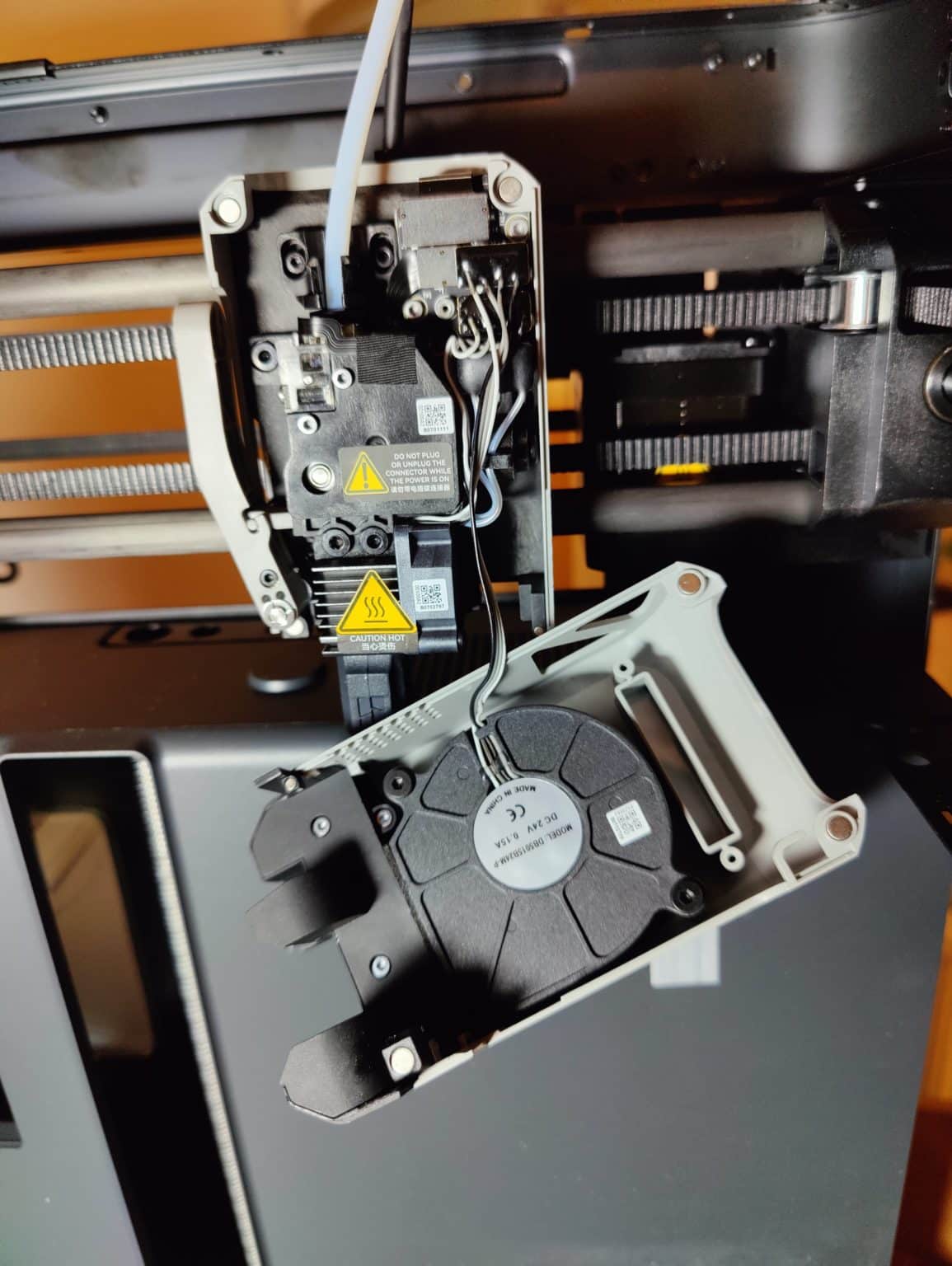
In addition, small plastic guides or elevations are attached to the two rear corners of the print bed, which enormously simplifies the exact alignment of the magnetically held PEI spring steel plate.
Last but not least, very useful for everyone like me who constantly forgets to calculate the remaining filament length: Bambu Labs own filament with an integrated RFID chip (for later automatic material and color recognition in the AMS) has an indentation with a scale from 800g to 200g , which provides information in 50g increments about how much filament is left. Every 90 degrees there are 2 holes on the side of the spools – so the filament end is never too long or too short.
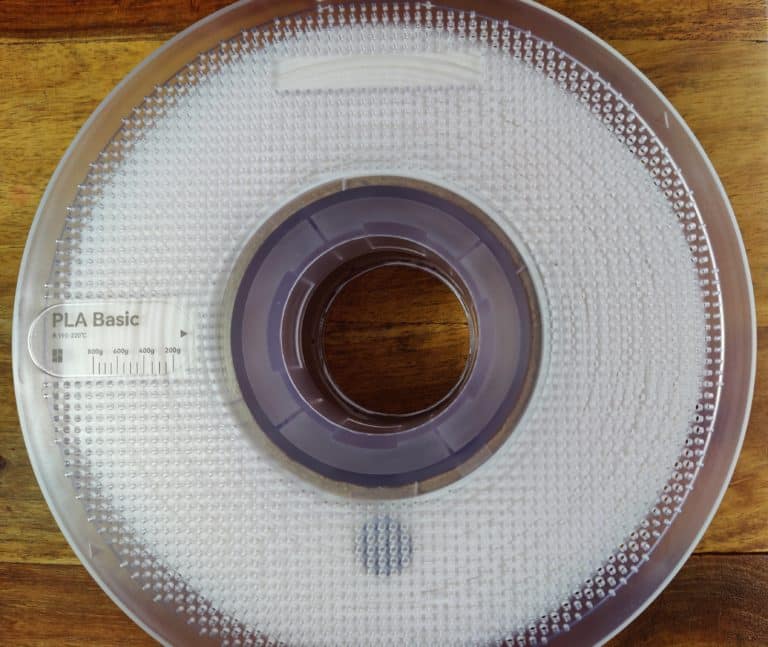
Last trick from Bambu Lab – this time in terms of sustainability: filament rolls are only sold with a cardboard inner wheel and an integrated RFID chip. Thanks to the .3mf file, you simply print out two reusable spool halves at home – an absolutely correct step towards a more sustainable 3D printing future.
Now the filaments at Bambu Lab no longer have to be sold out all the time, then far more Bambu Lab customers can put this idea into practice. Important, however: filament rolls with the same cardboard inner wheel are not suitable for the AMS without spool halves – just as unsuitable as TPU.
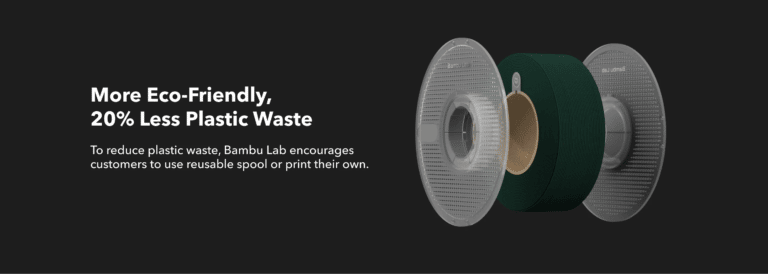
In summary, the structure is very short . Most of the assembly time is used to dismantle all the transport locks – in the spirit of Christmas presents: unpacking is simply beautiful.
Inside: look under the hood
13 screws have to be loosened on the back. Then you can take a look at the inner workings of the Bambu Lab P1P. There isn’t too much to see there though. First of all, the well-greased Z-spindle and the stepper motor underneath, which comes with a parallel guide rod, catch my eye. It is joined by two more spindles on the left and right at the front of the printer, each with a guide rod. Otherwise there would be the proprietary motherboard.
The only thing that stands out is that there is an AMS slot, which in turn is routed to a small circuit board via a cable extension, on the side of which the connection for the AMS is routed to the outside. Also at the start: A Meanwhell power supply that cannot be identified without lengthy dismantling , a few neatly routed cables covered with fabric tubing. Everything is crimped again, so the cable ends are provided with pressed-in wire sleeves of the cable lugs and additionally insulated – great!
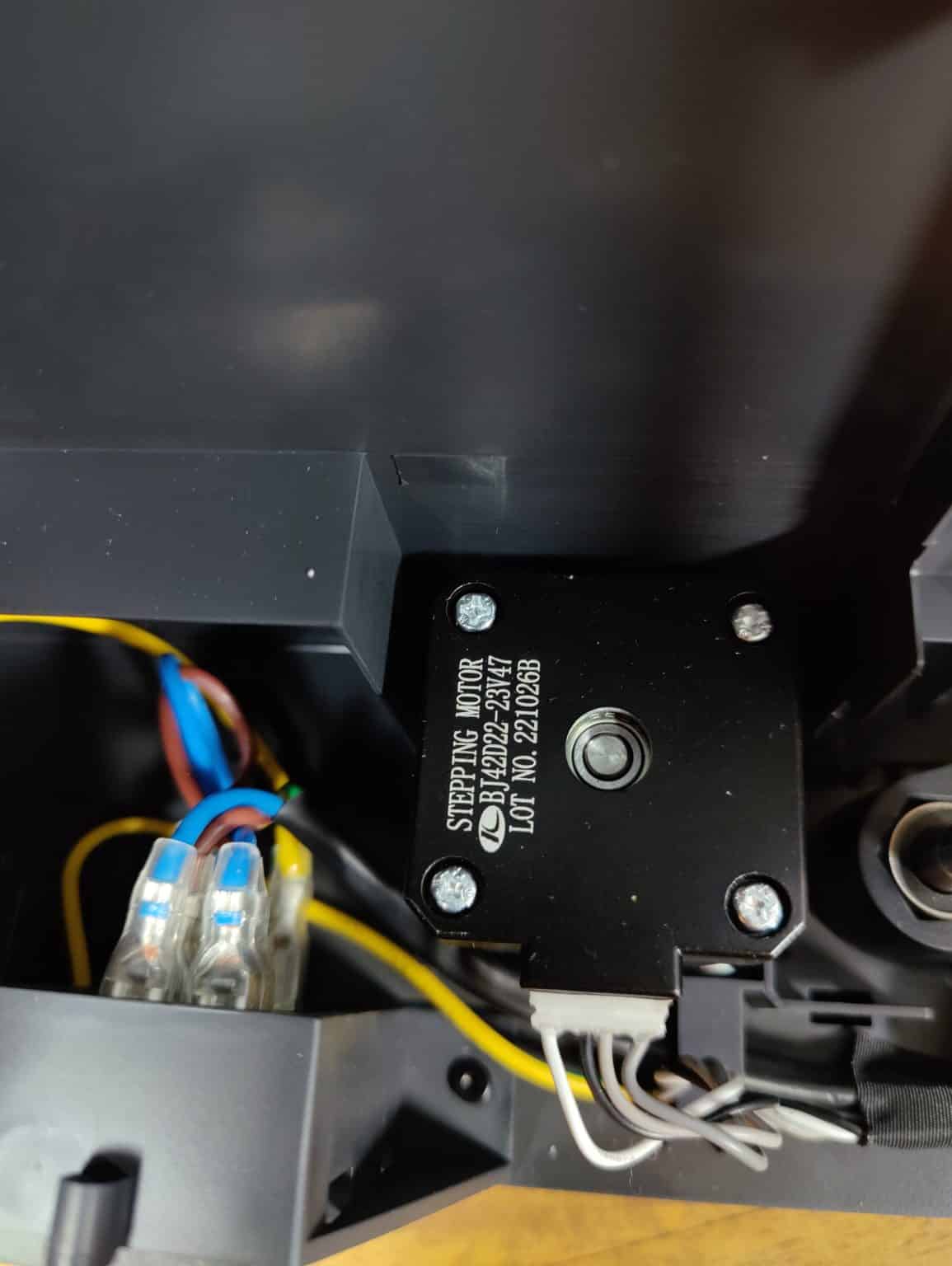
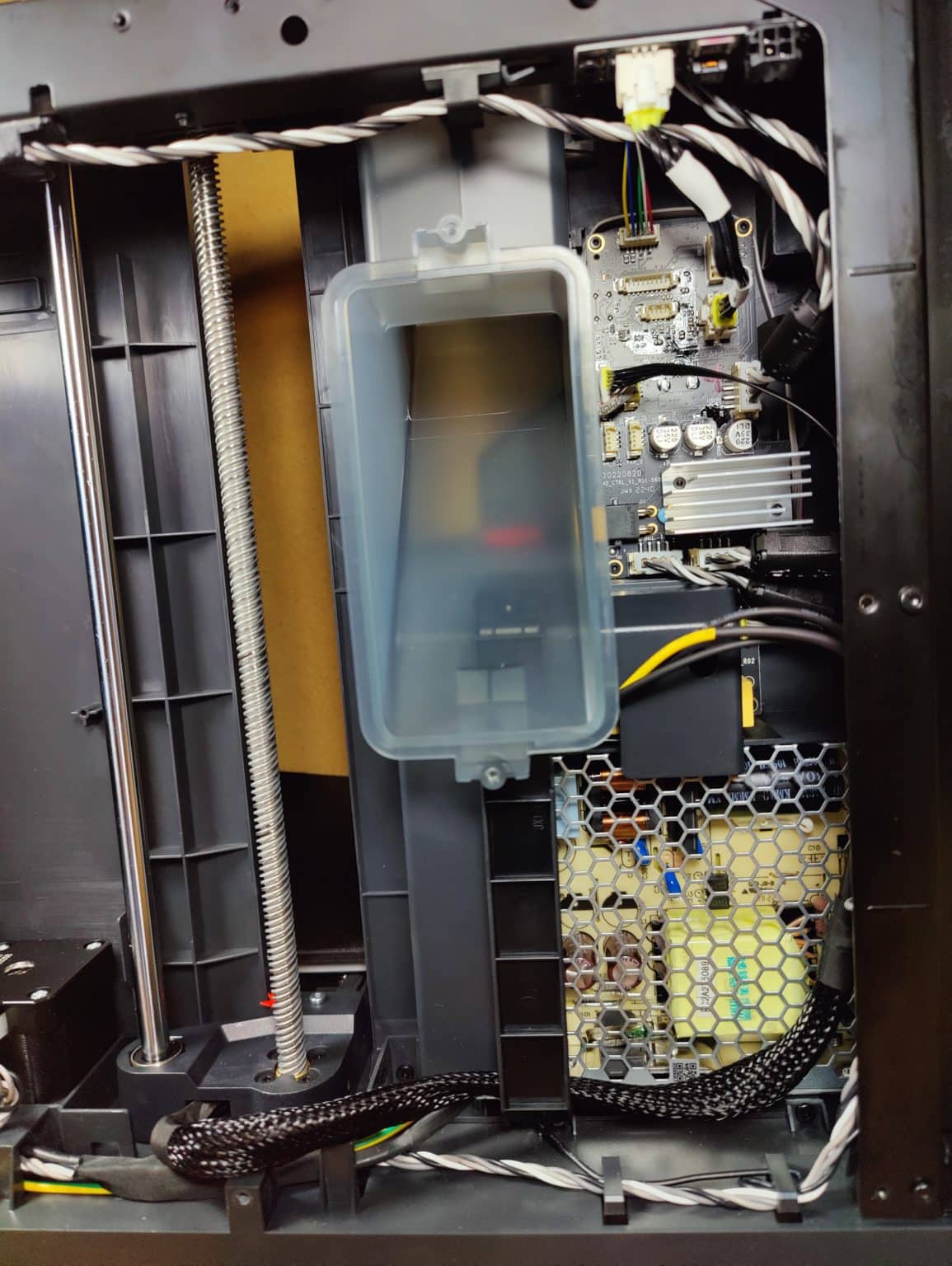
Commissioning: easy
I turn on the printer. The hotend fan can only be heard very briefly – that’s it – silence. That’s how I like it. But: During the initial setup, the power consumption is strangely constant at 22.5W – even if the printer is supposedly on standby in the meantime. That will change later, but it’s strange. We’ll come to more details in this regard elsewhere (see Features – Noise, Power Consumption & Temperatures).
The display welcomes me with the information that I have read all the instructions carefully before operation, that I have loosened the 3 transport safety screws, then asks for the world region and refers me to the app called Bambu Handy via QR code (see Features – App).
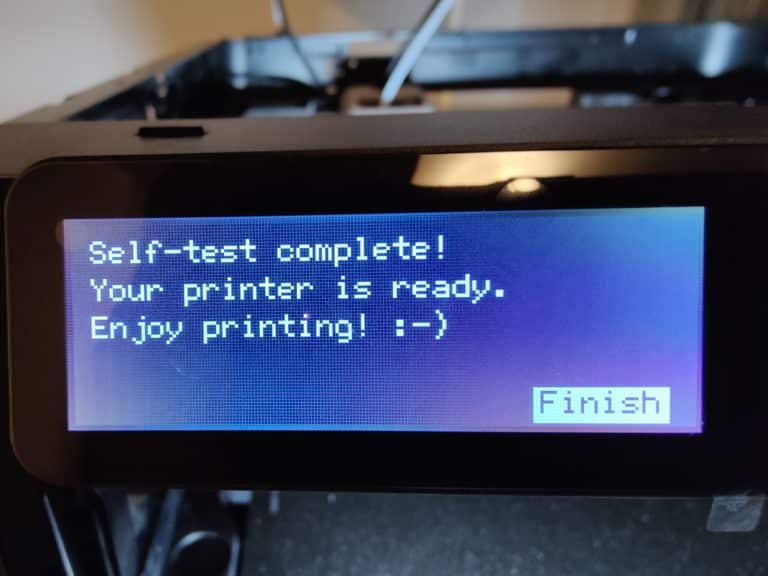
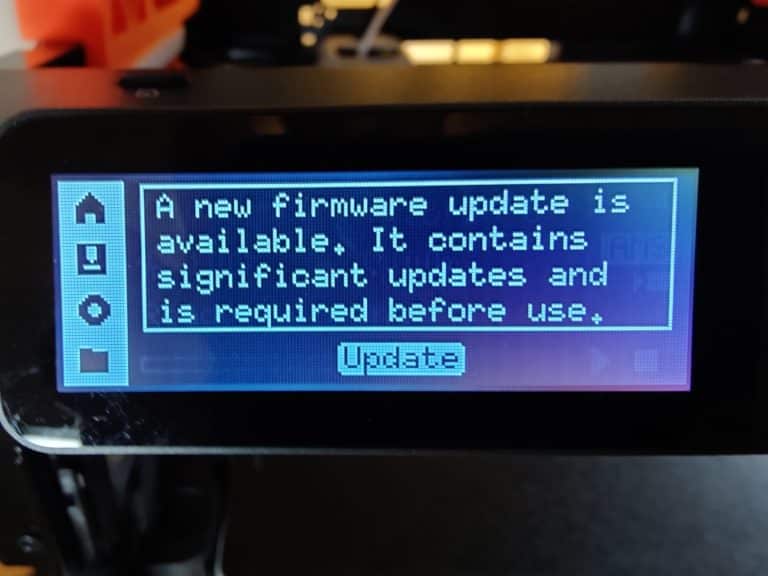
I click on “Add printer” in the app and the P1P is found directly via Bluetooth. Alternatively, I can simply scan the QR code on the display. Now quickly enter the WiFi network and password and zack – connected . The only small drawback: the app only likes 2.4 Ghz networks. As with the AnkerMake M5, the use of the smartphone app is unfortunately mandatory in order to set up and use the P1P.
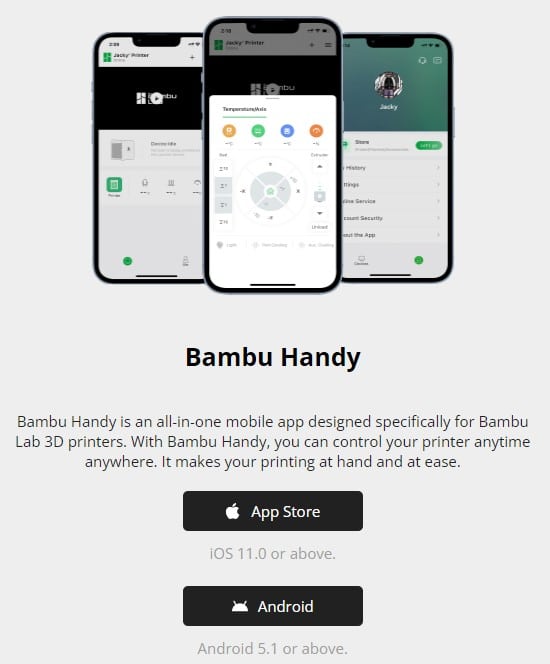
The display now tells me that the P1P would like to do a self-test to make sure everything is working properly. “Sounds good,” I think. So select “Start” and off you go. The print bed moves in 2 positions (far down and almost up) and vibrates in each case.
The print head then vibrates in the same way at different frequencies. Behind this is Bambu Labs automatic vibration compensation – better known to the competition as input shaping to reduce ringing and ghosting in later prints.
At the same time, Bambu Lab relies on Pressure Advance – i.e. a dynamically adapted filament extrusion – so that the edges of the printed model later appear as sharp as possible and any Z-seams appear as inconspicuous as possible. Malin calls a similar function Linear Advance. You can see the result of vibration compensation and pressure advance here:
I ca n’t put the AMS into operation immediately with the P1P . Since it is designed for the X1 (Carbon), I first need two adapter carriers , which Bambu Lab sent us – how could it have been otherwise with this printer – of course also as a 3mf file . I print them – of course – in orange PETG . Then the AMS is placed on top, a couple of PTFE hoses and 4- and 6-pin cables are plugged in between the AMS and the printer and everything is ready to use.
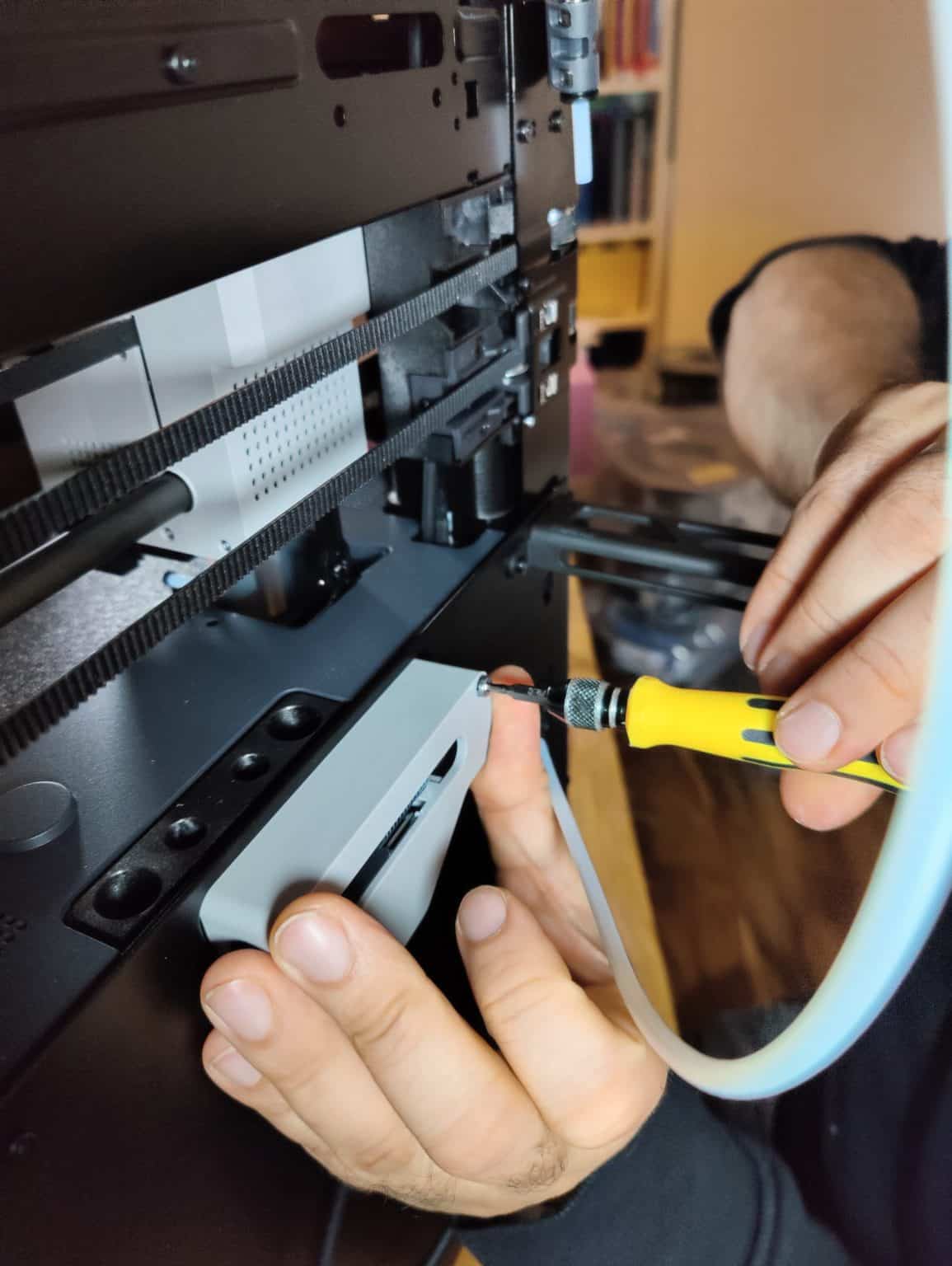
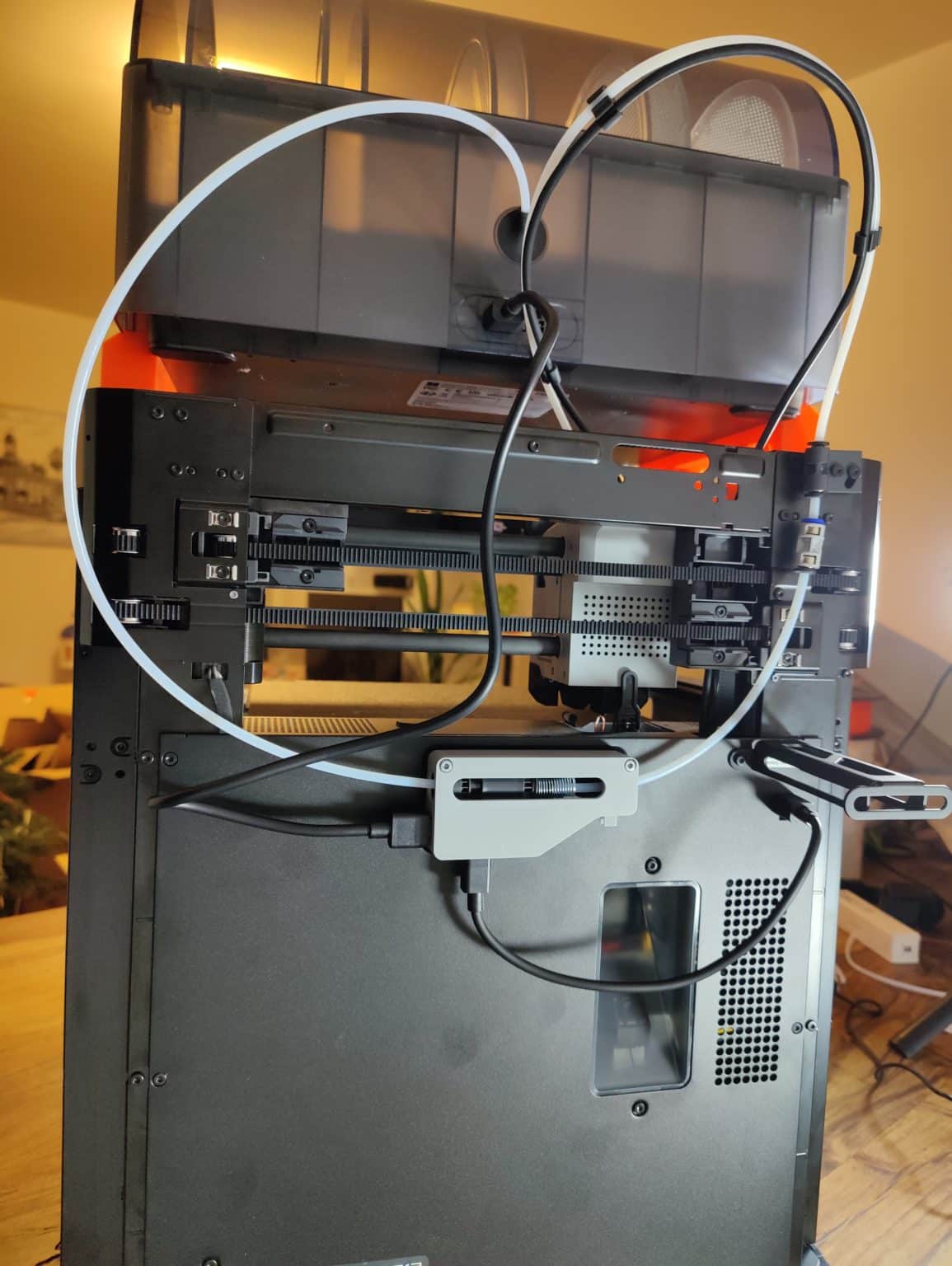
The AMS is automatically recognized by the P1P. If you open the hatch, which closes tightly with 2 latches , you are greeted by the four empty reusable coils, under which are two compartments with mesh lids, each for two large silica gel bags.
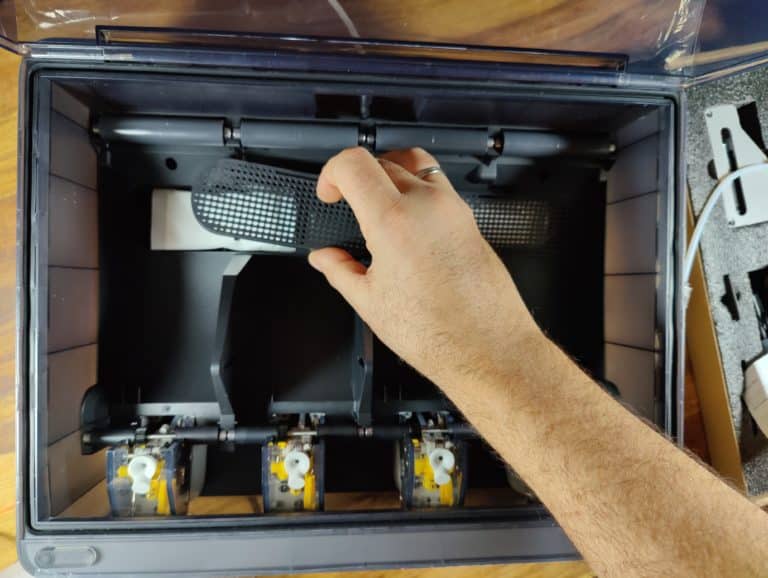
Features: Reduced to the essentials
- 2.7 inch display & menu navigation: simple
The partial headline says it all: “…Reduced to the essentials”. This not only applies to the body of the P1P, but also to the display. While the X1 (Carbon) still has a 5-inch HD touch display on the front, the P1P now has a monochrome 2.7-inch display with a resolution of 192 x 64 pixels with arrow keys, OK button in the middle, pause and back buttons. In terms of design, the display fits seamlessly into the “round” overall impression, although it suffers from backlight bleeding on all sides.
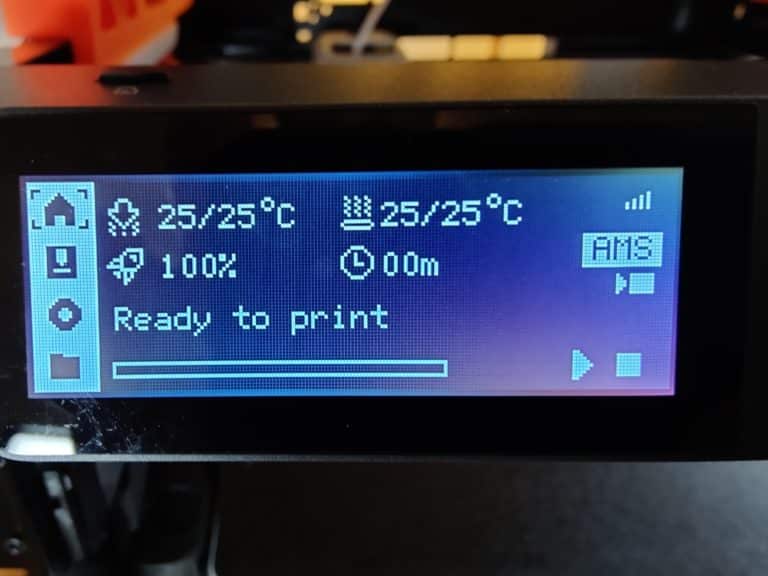
However, this small faux pas does not detract from the functionality. The menu navigation is clear and concise . Four icons are arranged vertically on the left.
First, the home screen (unsurprisingly with the house icon), which shows jet & bed temperature, WiFi connection signal strength (what a word!), speed percentage, time remaining, AMS status, print file, progress bar, and pause and stop icons. I would only have wished for a percentage for the progress bar.
Below the home screen, a nozzle is shown, which represents an area for print parameters, manual movement in x, y and z, and an “unload” function.
A rhombus, which is probably supposed to symbolize a gear, stands for information about your own connected Bambu Lab account, the WiFi settings and firmware version. Among other things, a self-test, calibration, standby timer or a factory reset are otherwise possible here.
Finally, the SD card memory is hidden under a folder symbol, which already contains a large number of 3mf files from Bambu Lab.
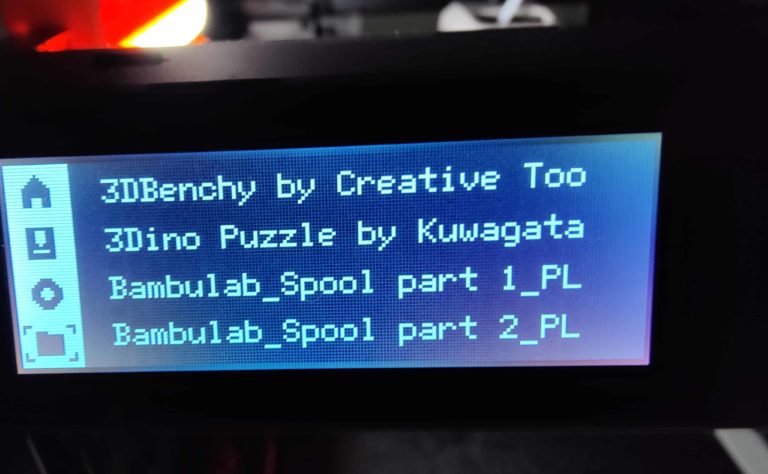
Magic auto-leveling & co: fully automatic
I first put Bambulab’s white PLA Basic filament on the filament holder, thread it in and… miss a load function. Instead, I have to bring the nozzle up to temperature manually and then extrude filament several times via the display. You could have done that with a corresponding function, after all there is also an “unload function”.
I briefly wonder why the auto-leveling was not completed in the setup process until I select the Bambu Lab Scraper as a 3mf file (spatula handle for the included blade) on the SD memory for the first print. Because as it will turn out later, the P1P levels by default before each print . However, this option can also be deselected. Just like the AnkerMake M5, there are no level wheels on the print bed. Instead, everything runs fully automatically in the form of an approx. 6.5 minute procedure, which is probably only surpassed by the X1 with the LIDAR sensor:
First, the print bed is heated to 60 degrees and the nozzle to 210 degrees. The print head moves to its home position , which is not coincidentally over a container at the back left, at the exit of which it is advisable to print a so-called poop chute , a filament waste bin, on the back of the printer. A little filament is now extruded there before the print head moves to the right over a filament wiper several times in quick succession.
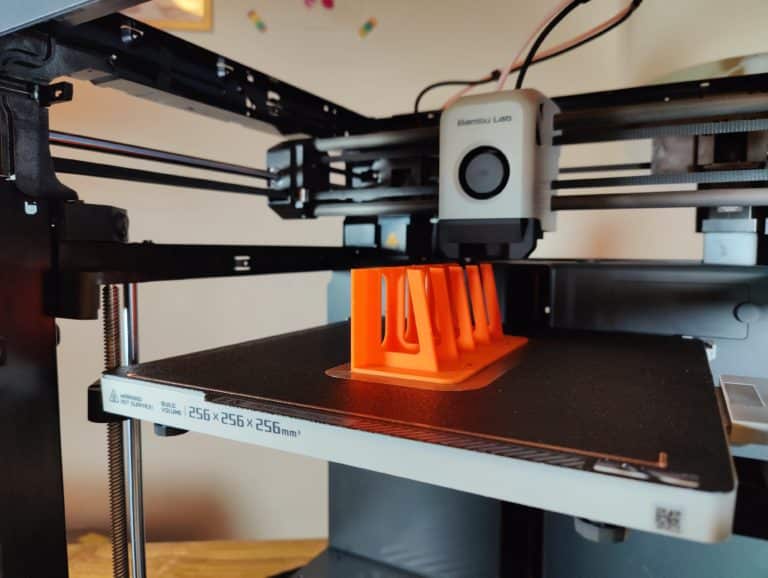
After vibration compensation in the print head, the actual multipoint bed leveling takes place by means of repeated contact between the nozzle and the print bed at a total of 36 points. The Z offset is also automatically adjusted at the same time. This is interrupted again by the print head vibrating at different positions. Now that 3 lines have been printed in the x-direction at the edge of the printing plate ( purge line ), the actual printing begins. What a hassle but well worth it with a perfect first layer.
Volume, power consumption & temperatures: loud, economical & inconspicuous
- Bambu Lab P1P Review: No slouch
I criticized it with the AnkerMake M5 and I criticize it this time too. I am aware that very fast prints require very potent cooling. But if Bambu Lab can somehow manage to get the volume to 60dB in normal operation in the future, then that would certainly be the icing on the cake on the way to the perfect 3D printer.
Without component cooling, we still get an average of 70dB from a distance of 50cm to the filament entry at the print head . If the double-walled component cooling is then switched on, it is at least 72dB . If I remember that the dB scale is logarithmic ( explained here super), then 2dB is noticeably louder.
But it is definitely too loud for me if you use the fastest mode (Ludicrious, 166%), because then an average of 74dB is recorded. In my opinion, the Bambu Lab P1P is at least a bit lower-frequency compared to the AnkerMake M5 and therefore more bearable. Amazing: With the 12W component cooler installed in the installation space, the values remain similar on average – even if he occasionally erupts in the meantime.
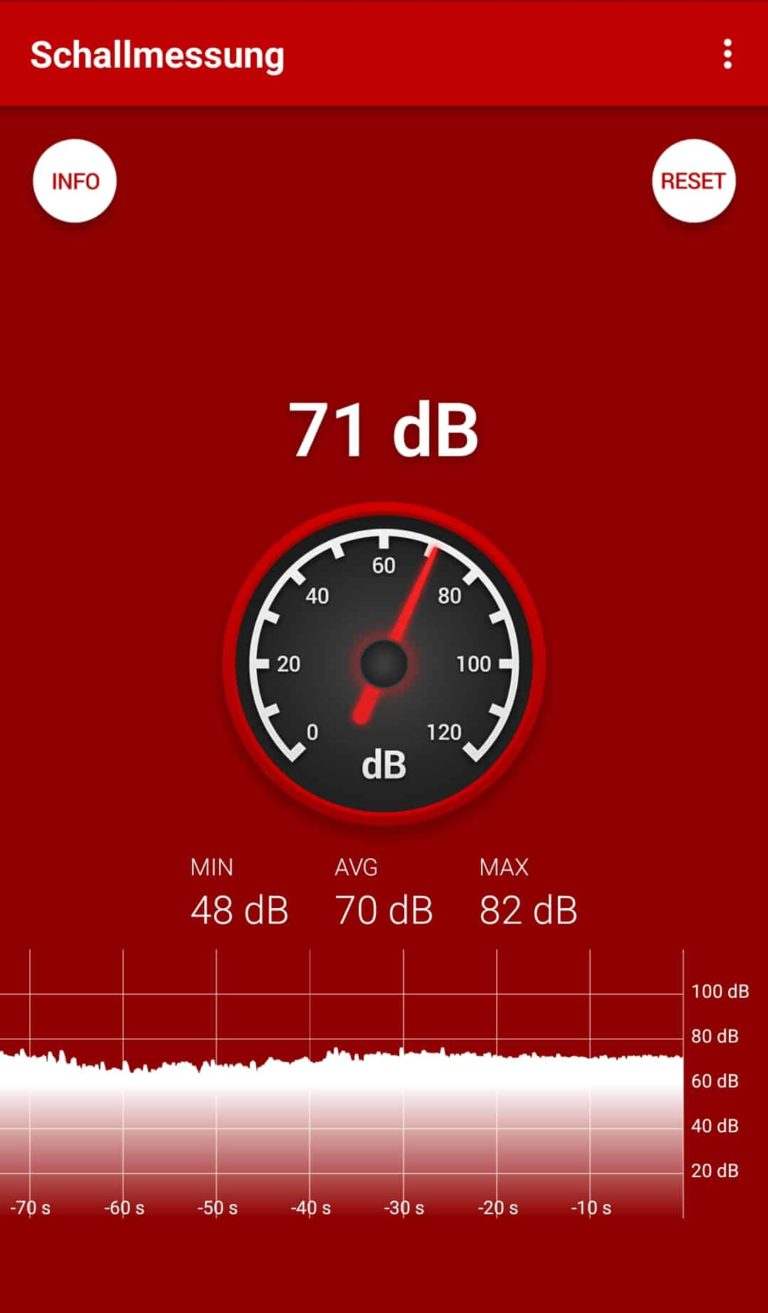
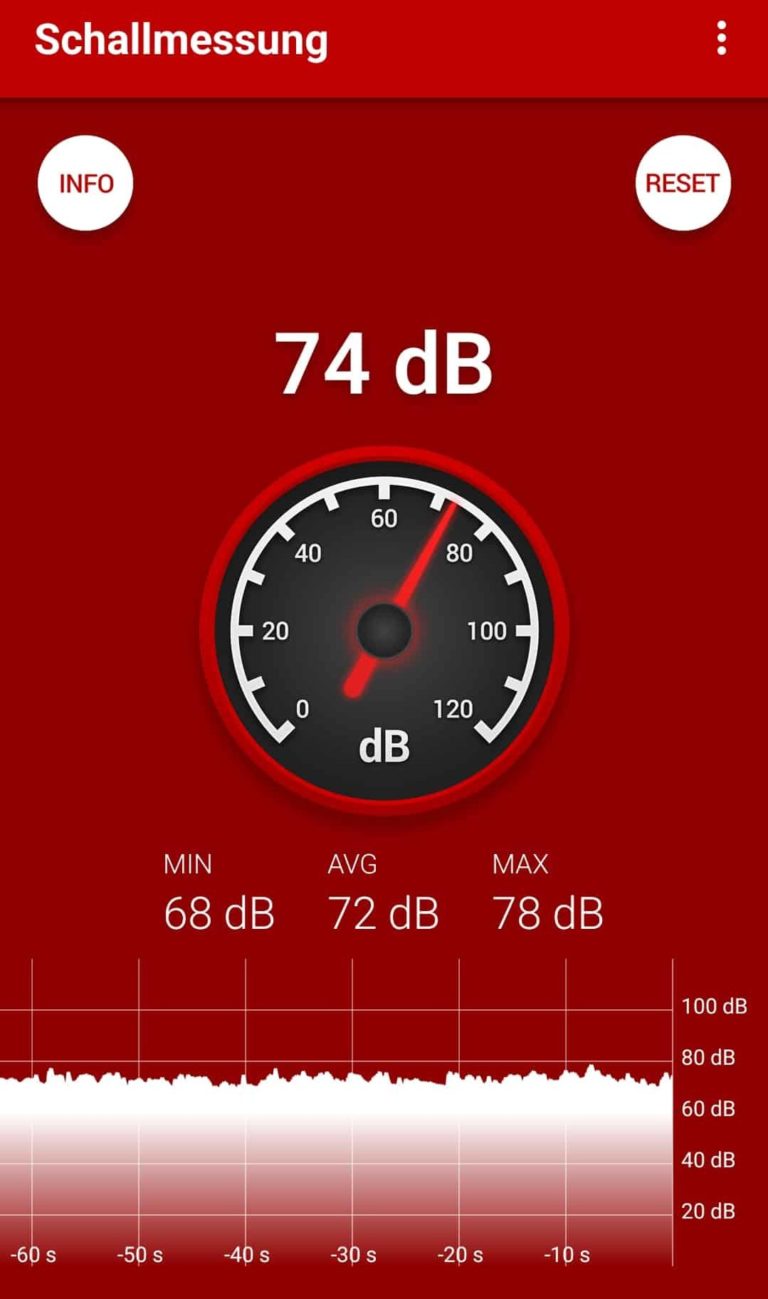
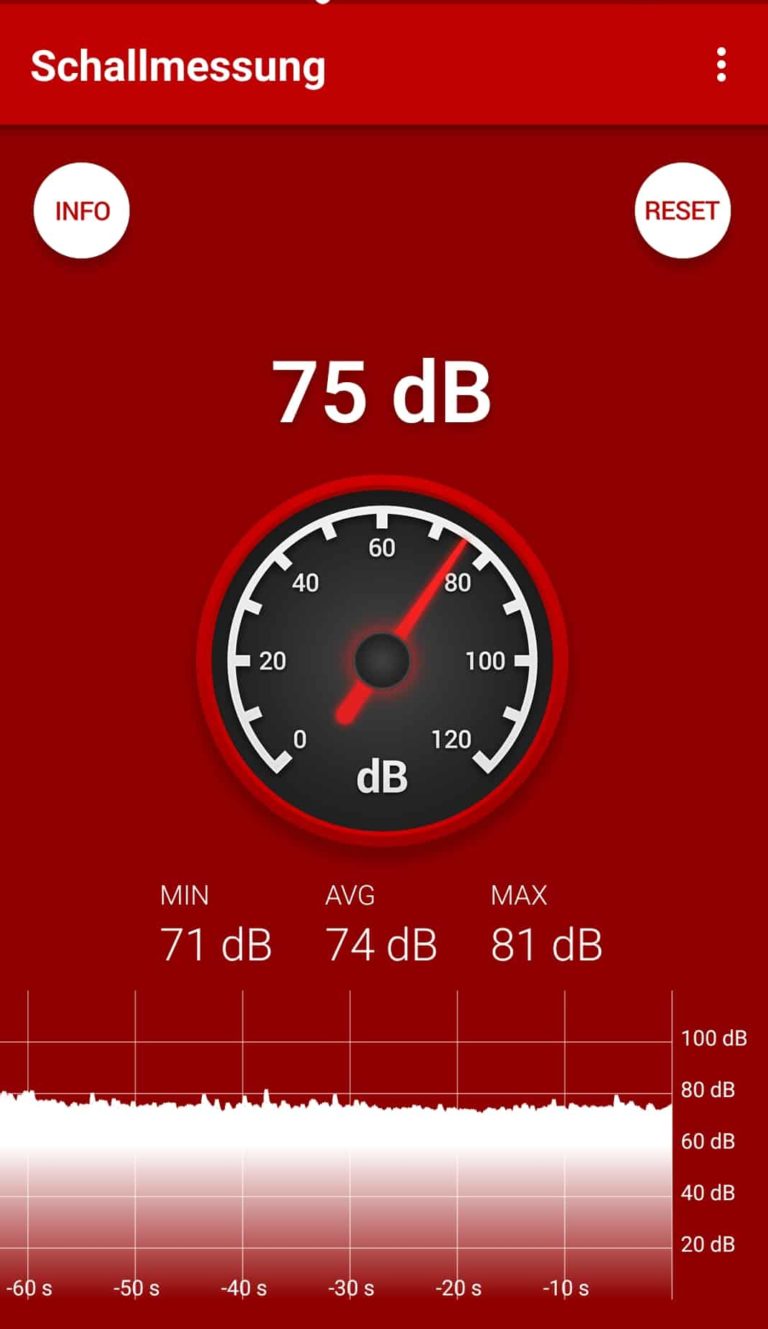
Economical contemporary
Further up in the text, I was either amazed or shocked that the P1P indulged in over 22.5W during the very first setup process, even during small rest periods. Reassuringly, that was only for the first time. In standby, Bambu Lab’s latest 3D printer is pleasingly frugal with an average of 4.6W . Even the small display then turns itself off.
If I print with PLA (220 degrees hotend to 60 degrees bed temperature), I end up with a very good 101.6W on average when the bed heats up in seconds. If the hotend then also heats up to 220 degrees (also in a few seconds), I am at 145.8W on average. With the level procedure, I get an average of 121.8W, while the actual printing then averages a good 139.1W. However, it should be noted that if you print in the fastest mode (Ludicrious, 166%), the P1P also consumes an average of 156.8W at PLA (200 to 60 degrees).
Temperature technically on target
Bambu Lab P1P Review / From each 3cm distance to the edge. So roughly where the level wheels are, I measure the temperatures at a preset bed temperature of 60 degrees and a waiting time of 15 minutes : I record 55.3 degrees at the front left, 53.1 degrees at the front right, 54.5 degrees at the right rear and 55.8 degrees at the back left.
Unfortunately, these inhomogeneous values are topped by the temperature in the middle of the print bed at 56.6 degrees. Overall, the infrared image also confirms a slightly warmer (from my point of view) left side of the print bed. However, this does not detract from the print bed adhesion at all. All stepper motors are also in the green range with a maximum of 53.6 degrees in continuous operation.
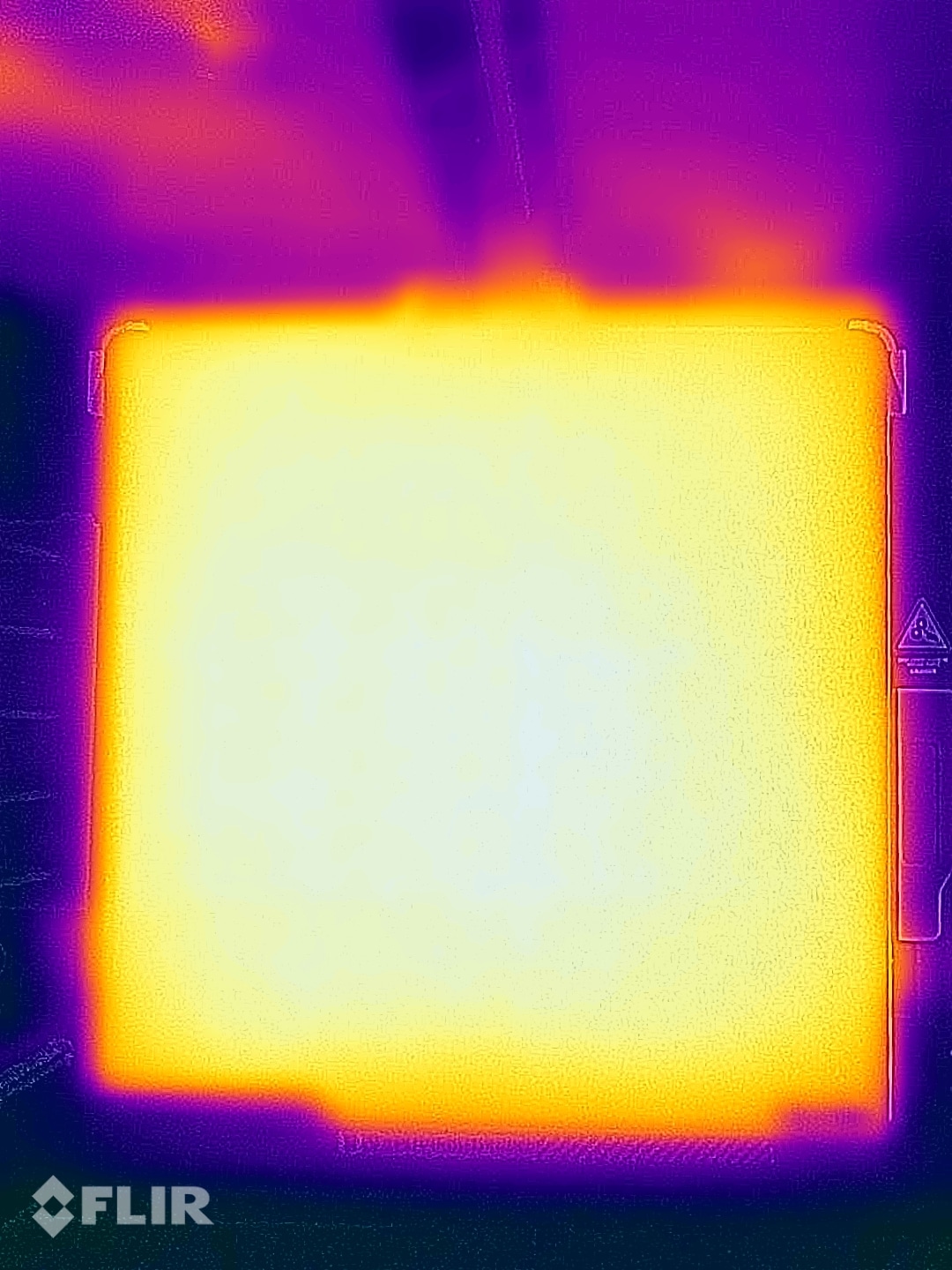
Software: tidy & intuitive
- App bamboo mobile
Bambu Handy is used as an app (iOS/Android). It was made available to us directly by Bambu Lab and is available in version 1.06 (12/07/2022). This is more recent than the officially available version 1.05 (09/23/2022). The app is wonderfully tidy and clearly designed. There are two central tabs: “Devices” and “Me”.
Under “Devices” you can see the printer name and status at the top left, next to it a plus icon for adding more printers and a settings icon. Behind this are extensive setting options for the printer, calibration options, power loss recovery function, editable printer name, timelapse function, printer list, firmware version and – particularly interesting – AMS options. The latter include options as to whether and when filament information should be updated and (only for Bambu Lab Filament) a residual filament estimate is desired. Just crazy.
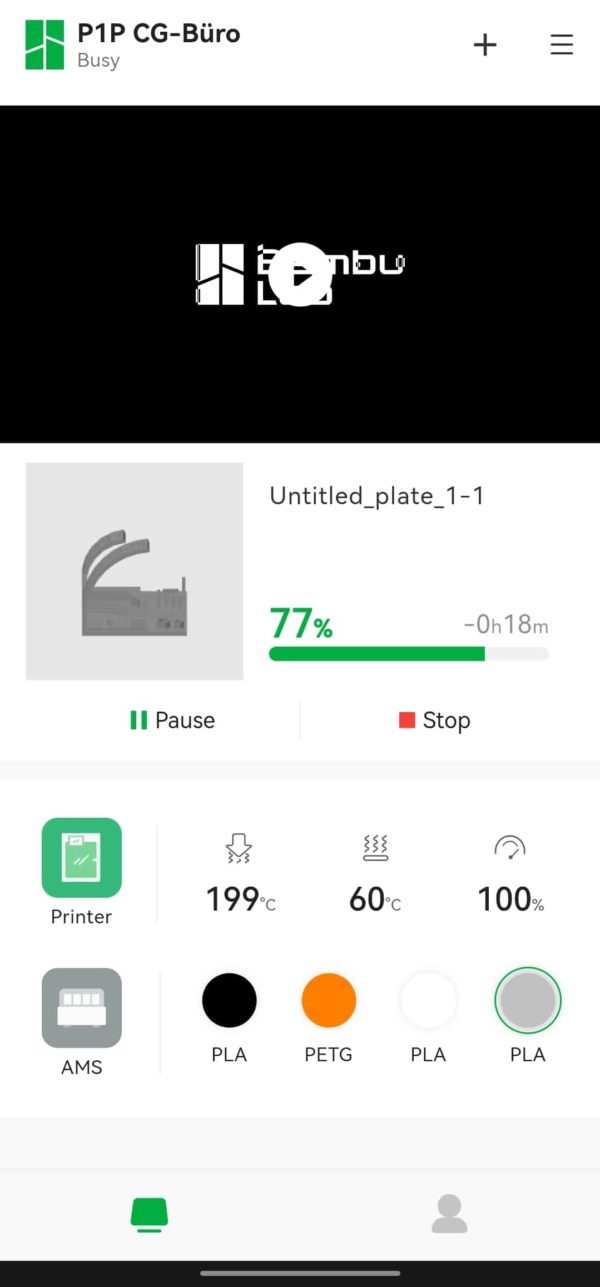
Particularly present at the top of the “Devices” tab: the live feed of the optionally available camera . Downside: Sometimes the feed works, sometimes a “Connection Failed” message comes up. Bambu Lab P1P Review has to do it again. What applies to both the app and the slicer: the camera image is good , but Bambu Lab limits the FPS rate significantly compared to the X1. I’d guess just 5 FPS , so the live camera feed isn’t good for more than a quick inventory. I find that a bit annoying.
Two lines can be seen under a printer graphic, which shows the printer status again: first of all, the “Printer” line (printer symbol) with changeable degrees for hotend, hotbed and speed display (we remember: Bambu Lab provides 4 speed modes here). A click on the printer symbol reveals additional control options in x, y and z with 1 to 10 mm increments, manual loading and unloading using an extruder and on/off functionality for light, component cooling and build space component cooler.
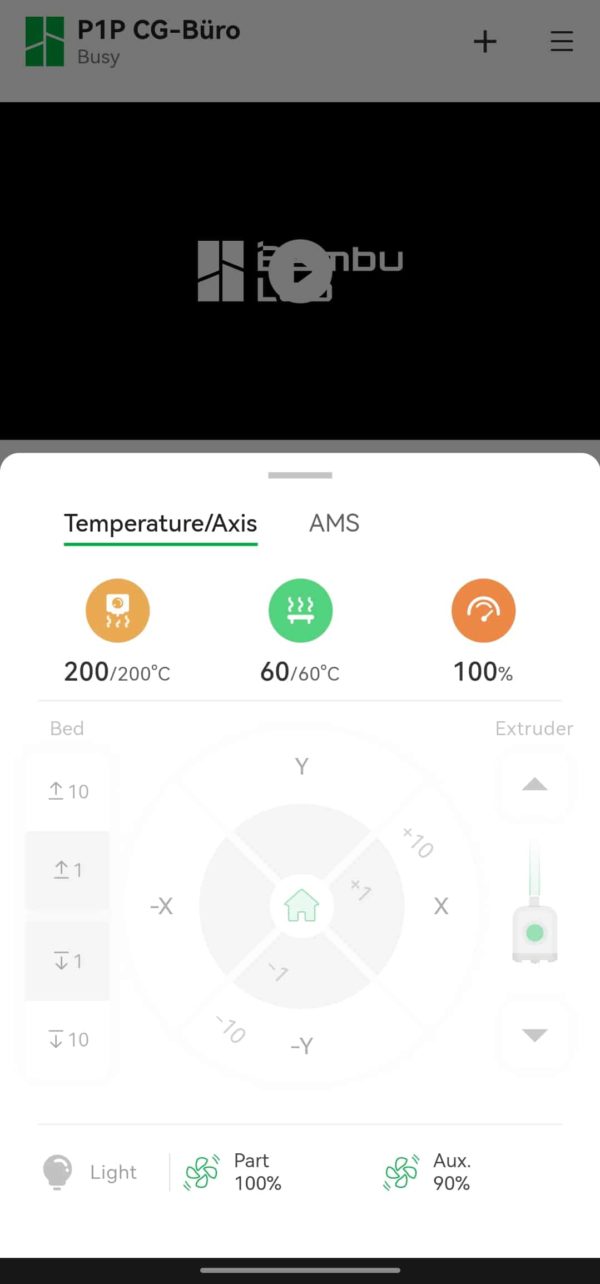
The area for the AMS is then under the “Printer” line. You can quickly see which slots are occupied by which filament . This can also be changed manually . If you also click on the “AMS symbol” here , the filaments can be loaded or unloaded in the 4 slots. I am impressed.
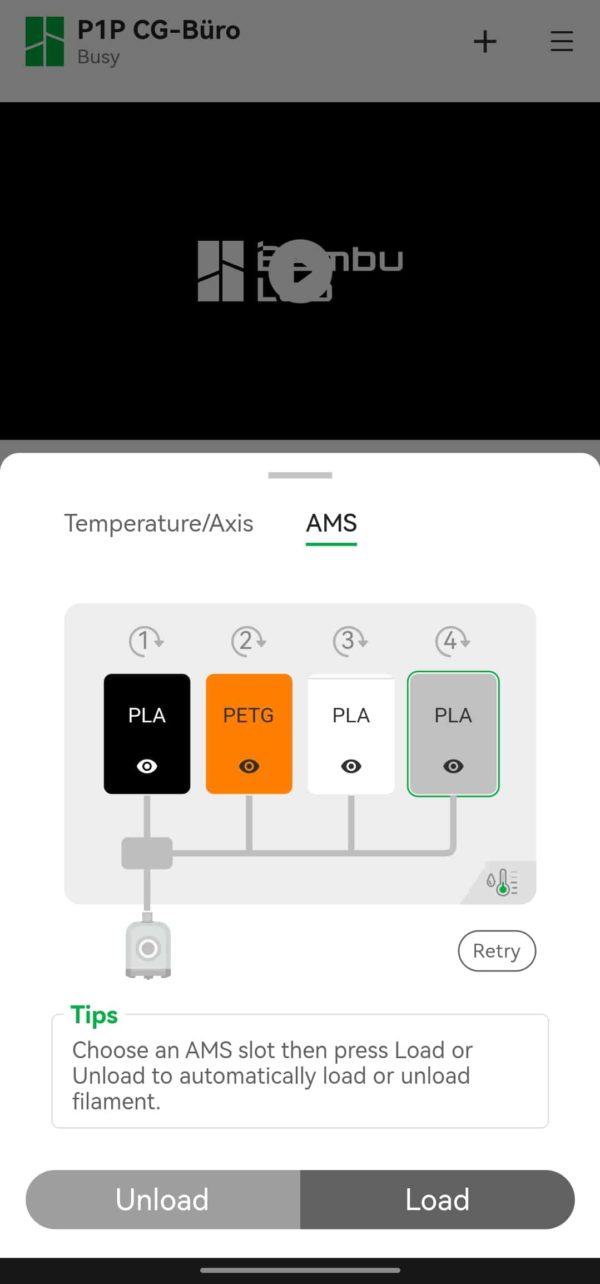
Not only the “Device” tab is well implemented, but also the “Me” tab, where I not only have access to my individual message center with previous print jobs (including a thumbnail of the print object) or to the Bambu Lab Store or the Bambu Lab Wiki . I can also see the status of my support tickets here , so if I need to contact Bambu Lab Support, I can use the integrated Bambu Handy QR scanner here or make account settings.

Slicer Bamboo Studio
This is where Bambu Labs proprietary slicer Bambu Studio comes into its own . The software is based on PrusaSlicer and Slic3r. Compared to the officially available version (v01.03.01.01-20221126112354), we got a more recent beta version (v01.03.01.03-20221129170324) for the P1P from Bambu Lab, which I have now updated to 1.04.00.18 (as of 12/20/2022). So turn on the computer, carry out the installation and be amazed that Bambu Studio now also supports Creality’s Ender-3 V2 and all important representatives of the Voron series in addition to its own models X1 Carbon, X1 and P1P – not bad, as many current models as possible!
The frontend is clearly structured. There are four basic tabs besides the home button . Above this is an anthracite bar with file options (open project, save, etc.), save icon and do/undo arrows.
The home button represents the start screen . A column on the left shows the profile status (logged in/logged out) as well as a “Recent” and a “User Manual” tab . The latter reveals tips and tricks for everything to do with the slicer. “Recent”, on the other hand, combines three central elements: a line with shortcuts for creating a new or opening an existing project , a line with current print inspirations from Bambu Lab (currently: Bambu Christmas Cabin as a printable multicolor model) and finally a line with print files that have been opened recently.
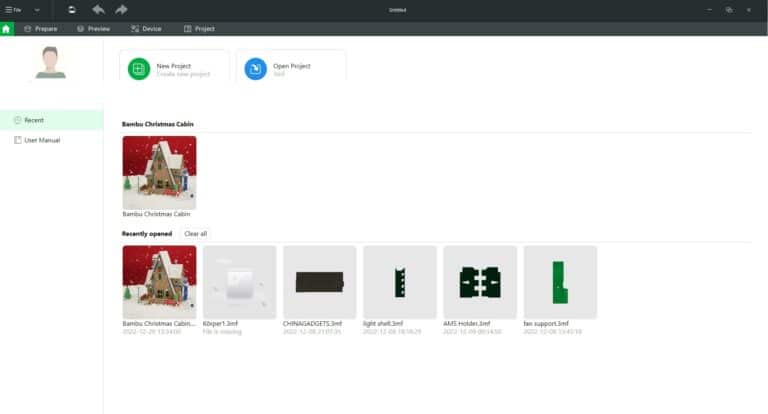
However, the four basic tabs mentioned are more relevant. Start with the “Prepare” tab . All relevant print parameters can be set here in the column on the left. Predefined profiles for Bambu Lab and Polylite filaments (Polymaker) are available for all Bambu Lab P1P Review models, as well as Voron Generic profiles and general universal profiles (Generic) for all supported filament types.
In addition, various print bed supports and all the options already mentioned with regard to the AMS can be selected. Speaking of AMS. I find it commendable that you can minimize the quite high filament waste in multi-color printing with the “Cleaning volume” option.
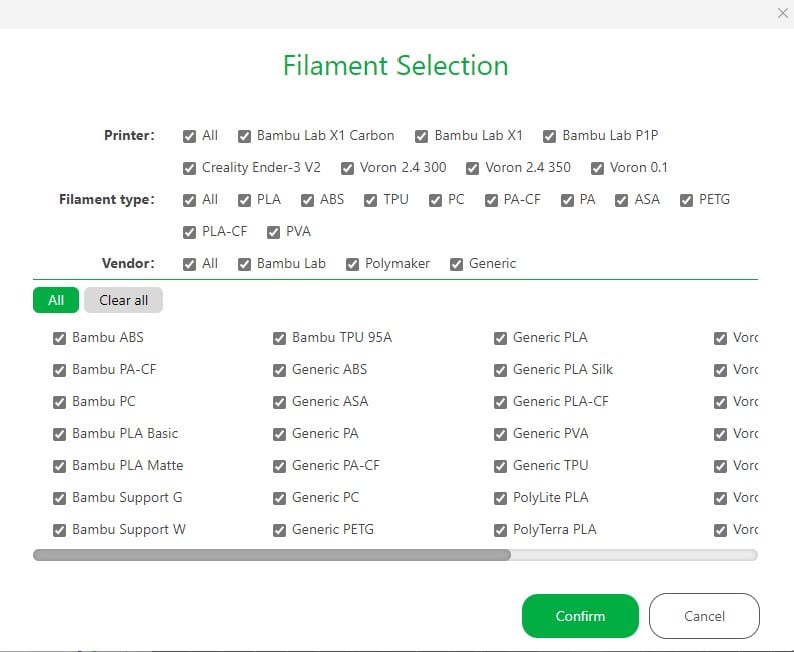
To the right of the column with all sorts of setting options, you can see the virtual printing plate, which has useful shortcuts such as locking the printing plate with the model to be printed. Above this is a toolbar that allows object modifications similar to Cura, but also exciting additional functions such as separating into several objects, painting support structures or adding text.
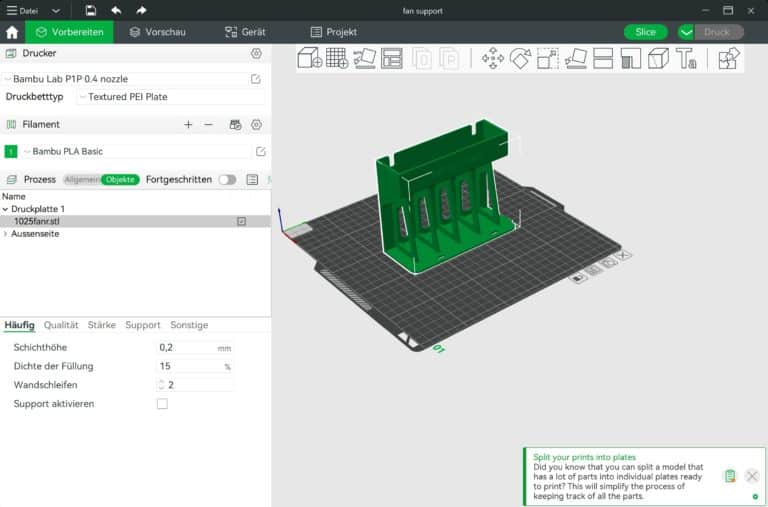
The icon for Bambu Labs Plate Management deserves special mention. Instead of having what feels like hundreds of parts on a print bed, Bambu Studio offers the division into several editions , so-called plates. In this way, a project (for this feature mandatory in 3mf format) is clearer, sources of error are reduced and instead of opening the slicer a maximum of 36 times to slice objects in a project, I can now distribute everything in one project to 36 plates. The slicer even remembers this without explicitly saving it: When a plate is finished, I select the next one and the next print starts directly.
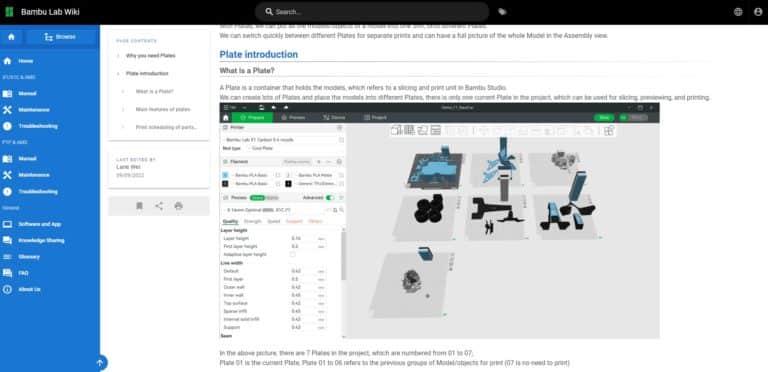
The ” Preview Tab” does what it says on the tin, but with aplomb: it provides a preview of the object to be printed after slicing. On the left in the said column with all the print parameters, I can switch from the general to the object view and now see exactly when which AMS slot becomes active for which area of my print.
However, I use the information on filament, line type and speed particularly often , which a drop-down menu provides me with 5 other parameters. Here I can see how much filament I use, how long the print with all sorts of partial times takes in total, broken down in the finest wayand by color scheme, at which speed it prints in which layer. My jaw dropped, especially when the information I was able to verify turned out to be largely correct after printing.
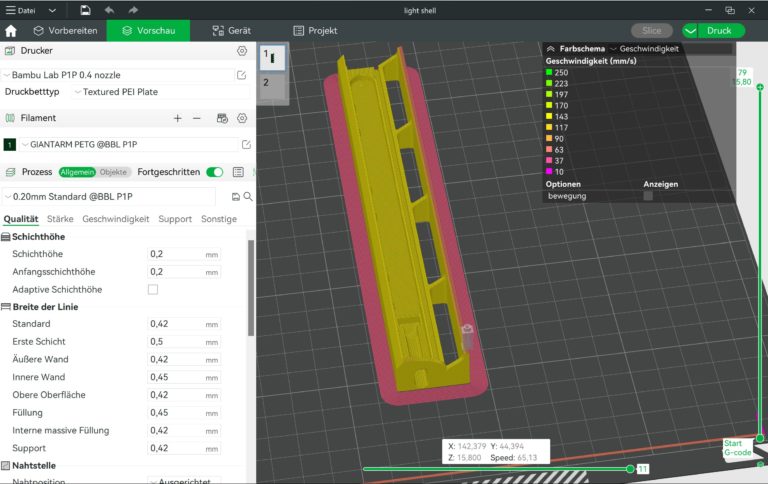
The “Device Tab” shows the camera live feed with settings for essential printing parameters, speed, light and fan switches, manual process paths in all three directions, an equally manual extruder extrusion and the AMS options (filament mapping/labeling, loading and unloading). In addition, a progress bar with percentage display and remaining print time as well as pause and stop icons are shown.
Something irritates me that some options seem to be “hidden” because the front end is not displayed correctly – no matter which of my three monitors I use the software on. Maybe that’s why I got theCan’t find timelapse recordings ( nor in the app, by the way, although both should actually have been implemented long ago).
Personally, I have n’t used the “Project Tab” yet. It is a kind of documentation tool for your own projects , in which printing information, images, material lists, assembly instructions and additional parameters can be stored. This could possibly be practical for my specially designed printing projects. If and to what extent I will use the tab, you will find out when the opportunity arises.
What I generally think is great, especially for beginners: if you hover over a setting with the mouse pointer, a brief explanation of the setting and its function appears directly. If this explanation is not enough, you can click on the corresponding parameter and end up directly in the extensive Bambu Wiki for exactly the setting that may still be unclear and you will receive additional information including videos or schematic drawings – simply: wow.
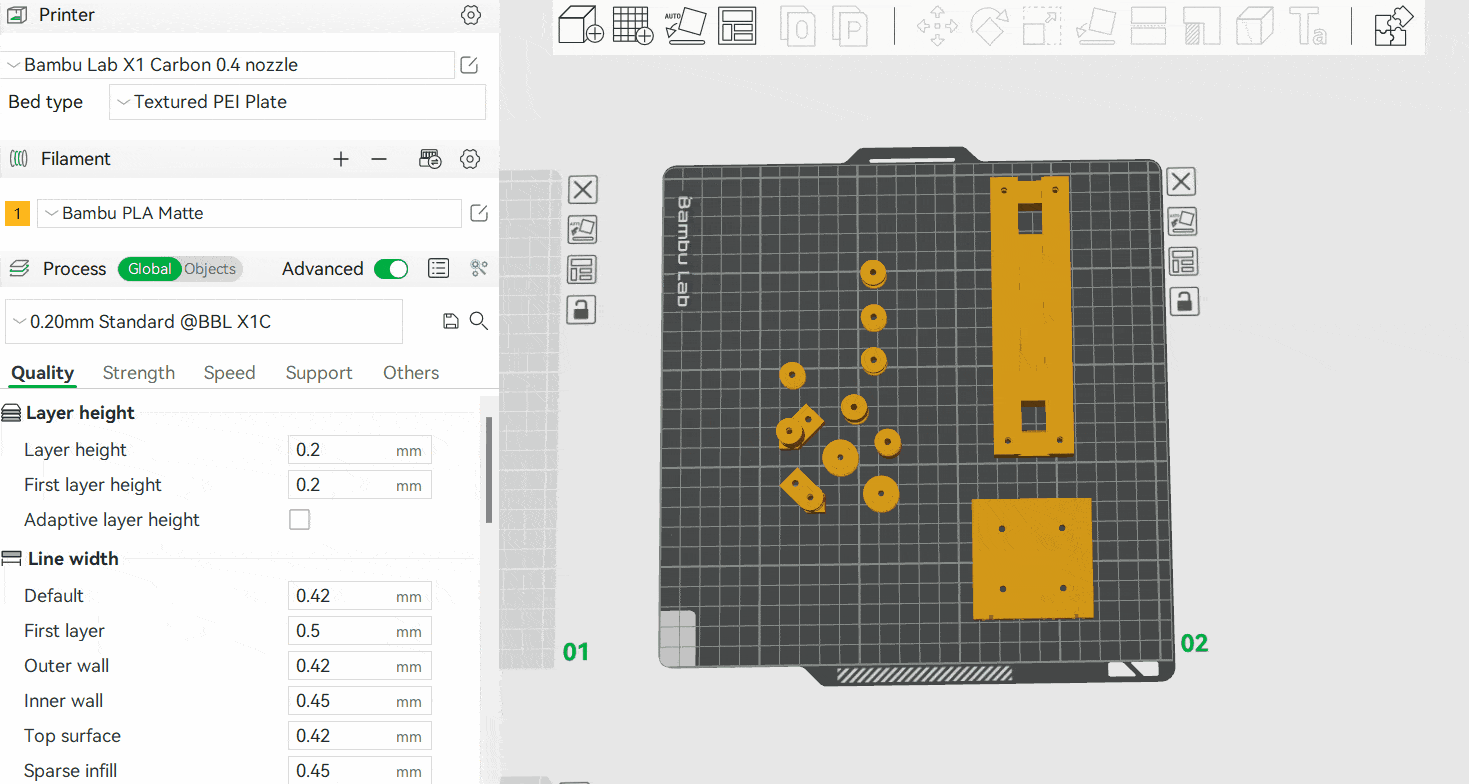
Less “wow”, on the other hand: Sending print files from the slicer to the printer works smoothly – but it takes a long time . In the case of larger print jobs, it is not uncommon for minutes to pass before the print job has actually arrived at the P1P via the 2.4 GHz WLAN (unfortunately no 5 GHz). This is due to the fact that Bambu Lab really first sends every print job to the in-house cloud, the printer then downloads it and then has to unpack the corresponding zip file and only then starts to print.
The only explanation I can give for this approach is that Bambu Lab, as a young company, diligently collects data in order to be able to optimize the user experience. At some point, however, this should end – after all, we live in Germany, which is not quite as fast and progressively networked digitally. – Bambu Lab P1P Review
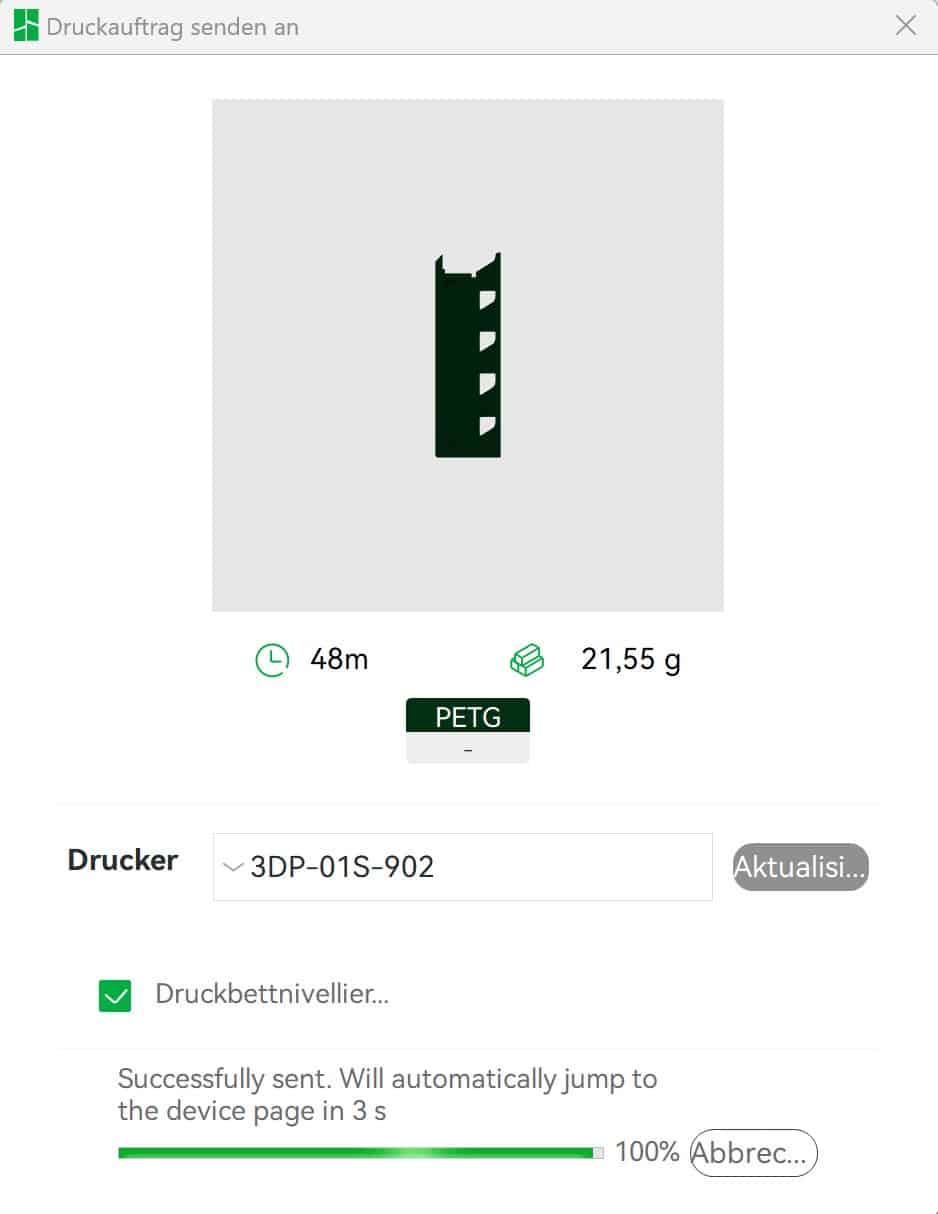
Comparison to Bambu Lab X1 (Carbon)
In contrast to the Bambu Lab X1 in the “Carbon Combo” version, some features have to be sacrificed in view of the price. There are no LEDs installed in the interior, nor is there a touchscreen. Users will have to make do with a micro SD slot. An activated carbon filter is not available from the manufacturer for the P1P.
However, the most important thing (not) is that the Bambu Lab P1P has no micro LIDAR sensor and no NPU installed. It is not yet known whether this can be retrofitted in the future. Otherwise, as already mentioned, many functions can be retrofitted or are optionally available. All Bambu Lab printers (combinations) can be found in comparison.
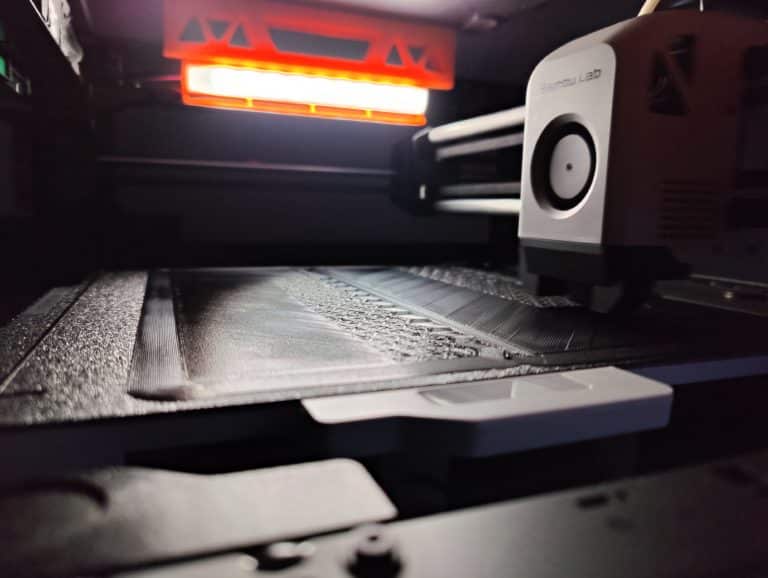
AMS in action
If I take the enclosed filament spool , thread just a little of it, then the AMS pulls out a small piece of filament automatically and a small white LED on the filament feed makes it clear: This slot is occupied – with Bambu Lab Basic PLA in white. Thanks to the RFID chip, the P1P knows this and also displays it in the slicer and app. However, if the filament does not come from Bambu Lab, this can be quickly set manually.
All LEDs light up white when the corresponding slots are occupied. If a filament is in use, the corresponding LED will flash slowly. The AMS could also be exciting in the future when I test Bambu Labs special support material. Until then, it should be said: the AMSdoes what it should, uncomplicated and fully automatic allowing multi-color printing – great!
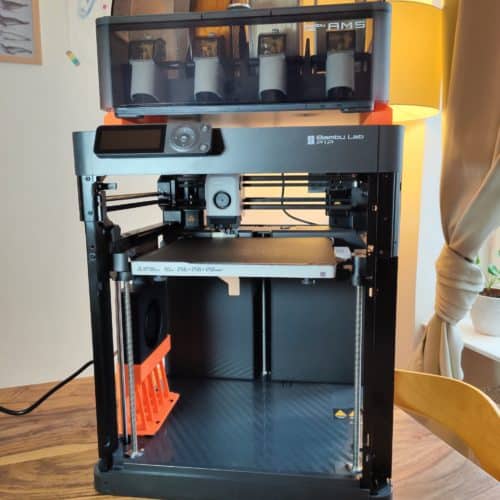
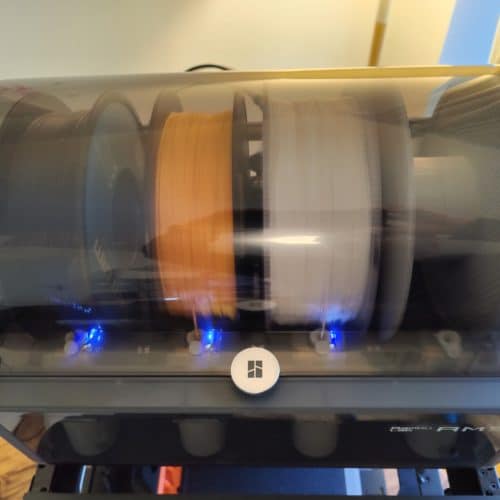
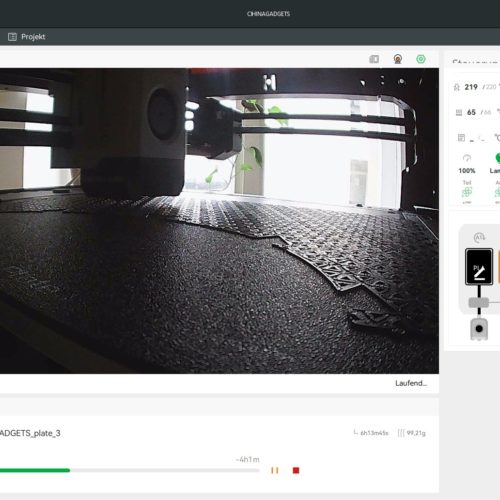
Speed champ & (almost) everything printer
The P1P can print at 500mm/s just like the X1 series , but the same hotend nozzle combination is installed. In practice, of course, such high printing speeds can never be achieved (for a long time). Nevertheless, there is a clearly noticeable time saving. The printing speed varies constantly for each print object. Consequently, Bambu Lab does not opt for fixed mm/s values for the four predefined speed levels , but expresses them as a percentage.
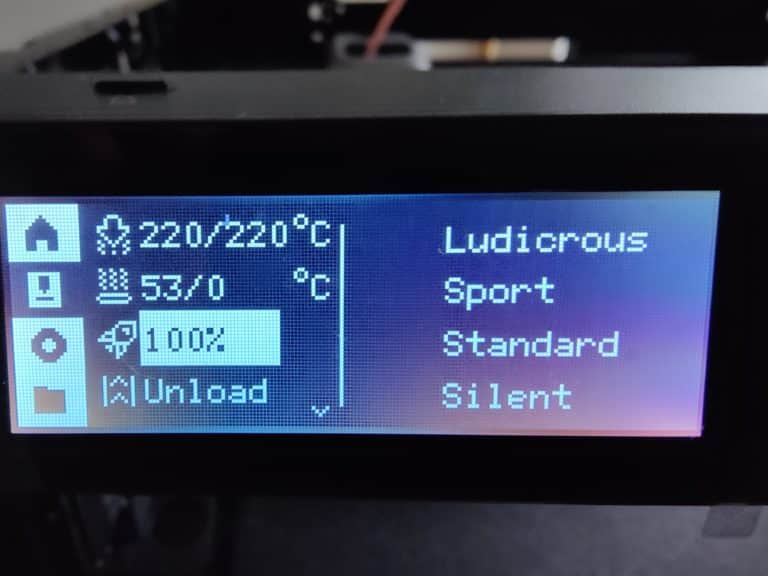

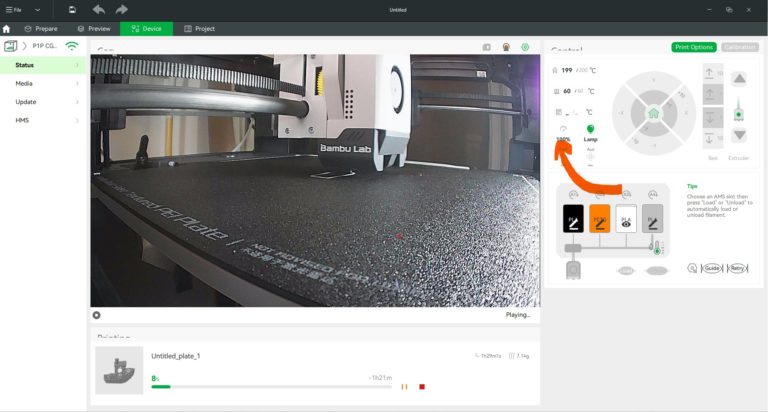
In standard mode (100%), the P1P is always between 20 and 250mm/s, depending on the model. In silent mode (50%) we then get into the well-known 50 to 60mm/s region. If the finish doesn’t have to be perfect, you can also use the sport mode (124%) . 300mm/s are then quite possible. According to Bambu Lab, it gets “crazy” with the ludicrous mode (166%) . Then the P1P scratches the 500mm/s benchmark much more often.
The P1P prints PLA, PETG, TPU, PVA, ASA, PETG, ABS/ASA, PA and PC. Since it does not have a housing from the factory , an appropriate casing should be provided in order to be able to print materials such as ABS successfully. Printing with carbon and glass fiber reinforced polymers is not recommended .
Print Results
First of all, it should be emphasized that all print results without parameter tuning, with one exception, came out of the Bambu Lab P1P as good to very good – each with a perfectly leveled print bed beforehand . The only anomaly, which is actually not one: Bambu Lab prints PLA at a bed temperature of 65 degrees by default. De facto, only around 60 degrees of this actually arrives at the top – in this respect: everything is ok.
Bambu Lab handles the printing speed dynamically. She changes constantly. That’s why I give the lowest and highest speed value as a range here. The printing times always include the start procedure (approx. 6.5 minutes). Layer height is basically 0.2mmwith the built-in 0.4mm nozzle. Let’s take a closer look at the printed objects to see what all this means in concrete terms.
Bamboo Lab Scraper
As already mentioned in various places, Bambu Lab supplies a blade that becomes a full-fledged spatula with the digitally available 3mF file. Using the supplied white Bambu Lab PLA Basic filament (220°/65° C), I printed the handle, a screw-on counterpart for the blade and a small holder for this so-called “ Bambu Lab Scraper ” directly from the SD memory of the device. All the parts come out of the printer like a dream – after 1:06 hours at speeds of between 78 and 258mm/s predefined by the Bambu Lab.
At most, I can see minimal artefacts here and there and a partly visible Z-seamdetermined. Nevertheless: A successful interaction of Bambu PLA Basic Filament and the P1P. The only disadvantage: We have exactly 1 filament roll from Bambu Lab and only in white, which is difficult to capture with the camera. But that should change as soon as possible.
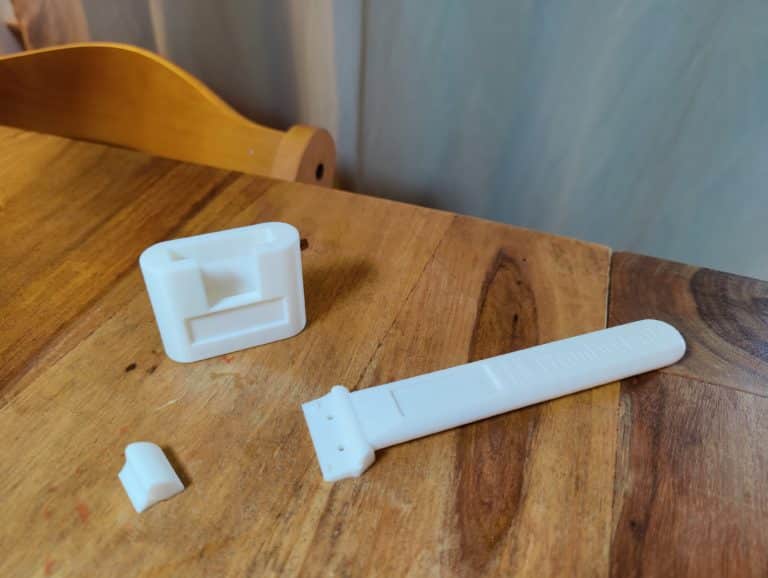
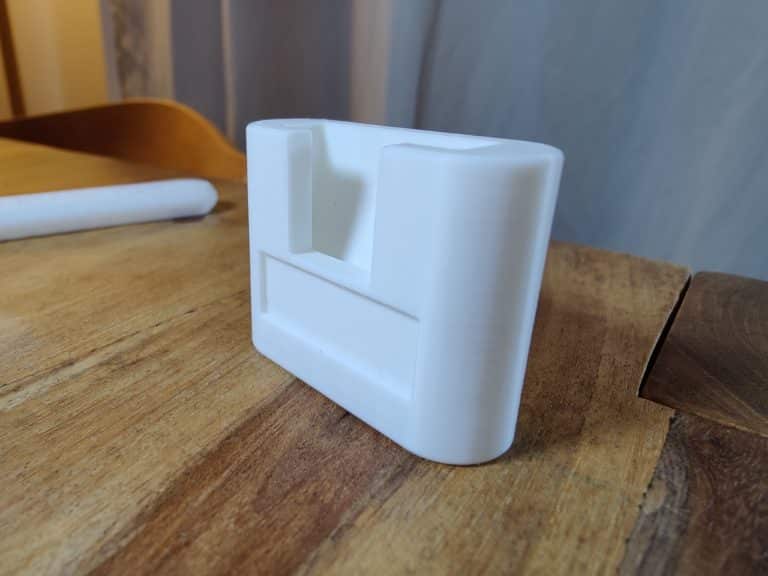
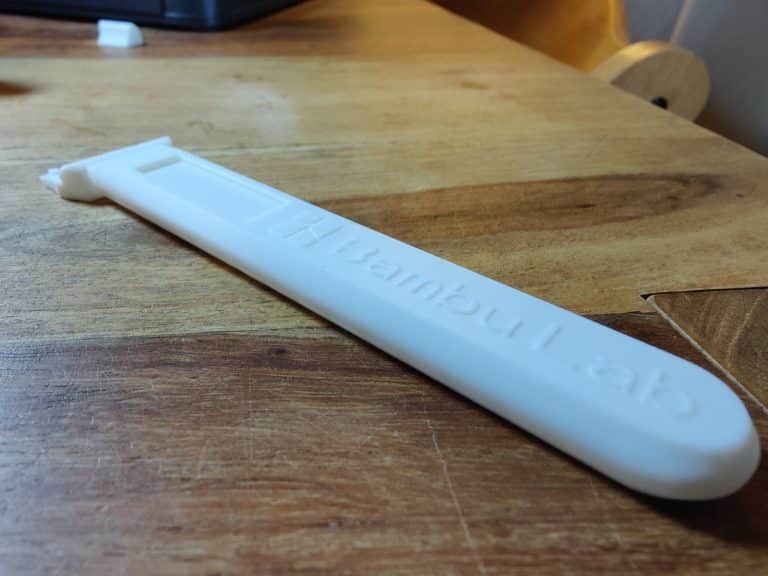
Bamboo Lab Fan Support
In order to be on the safe side later for the planned housing of the P1P (pressure chamber temperatures above 60 degrees should be possible), I rely on CG-typical orange in PETG for the “ Bambu Lab Fan Support ” – we remember: the support for the installation space component fan that is slowly detaching in the X1. Since the latter can only tolerate a maximum of 250 degrees, I lower the nozzle temperature of the Generic PETG profile in the Bambu Studio by 5 degrees (250°/80° degrees).
The pressure actually comes out okay at predefined speeds between 150 and 250mm/s after 3:22 hours , at a certain height, however, clear pressure problems can be identified. Also, under-extrusion can be seen at the top of one face while the other face looks good. However, these blemishes do not detract from the benefit. Since then, the fan support has been in the P1P and ensures that the installation space component cooler, which is optional with the P1P, is firmly seated.
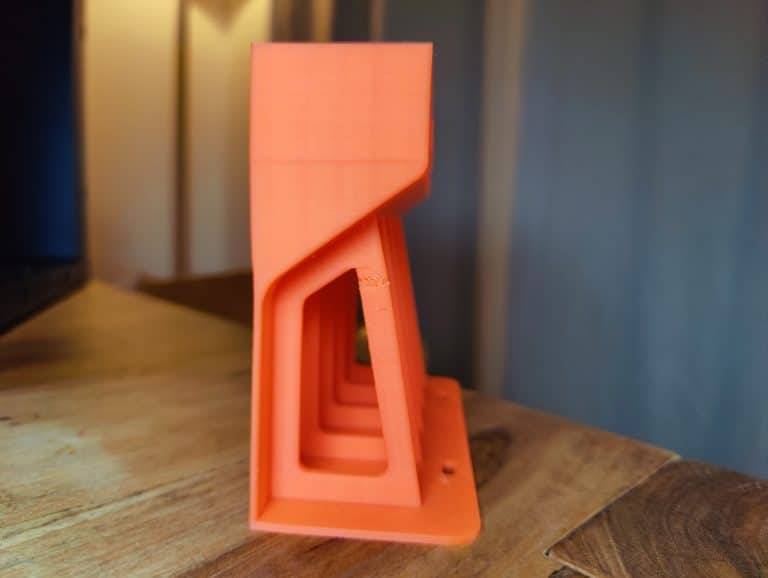
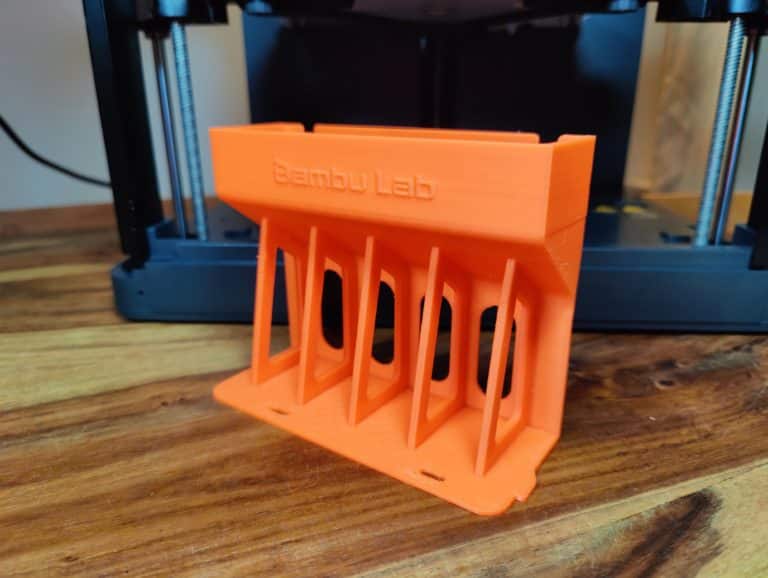
Bambu Lab LED mount
Next up is the housing for the supplied LED. It consists of two parts – a frame for the LED bar and a white LED cover that is pushed onto the side of the frame. Because the LED will also be in the later closed installation space, I choose PETG : for the frame in orange , for the LED cover in white (each 250°/80° degrees, 50 to 250mm/s, 49:47 minutes) . I have nothing to complain about with the frame apart from minimal stringing , the LED fits perfectly into the recess and is held in place with small retaining clips.

However, the white LED cover has noticeable artifacts (as always, it looks worse in photos with highlighted lines). However, in view of the good experiences with Bambu Lab’s own PLA and – with small drawbacks – the orange PETG, I clearly attribute this to the PETG filament, whose Chinese manufacturer I cannot remotely pronounce. The first version of the LED cover printed on edge was actually the only misprint due to detachment from the print bed – here I used the supplied glue stick from Bambu Lab on the second attempt (the only time ever) and everything was ok.
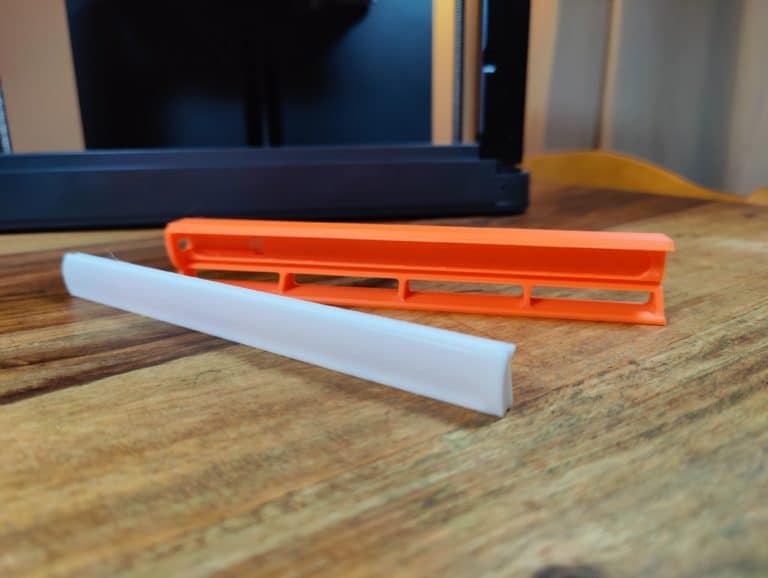
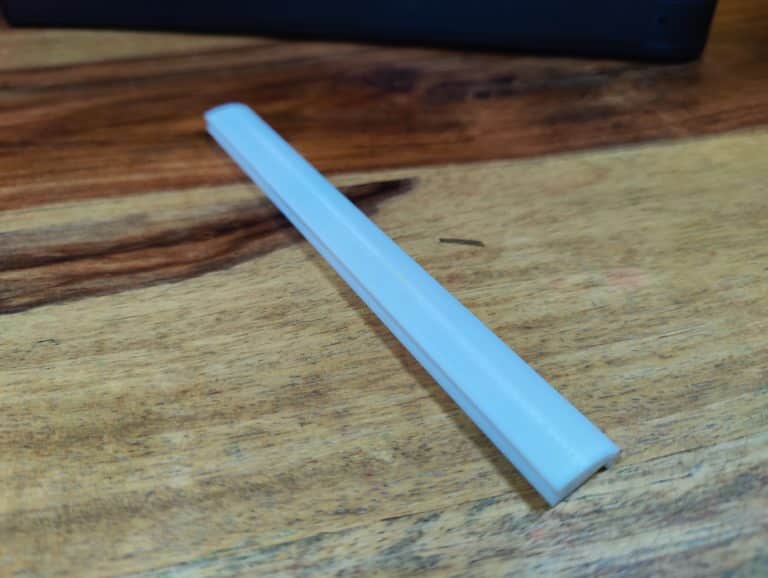
Bamboo AMS Holder
Let’s continue on our P1P DIY mission with the “Bambu AMS Holder” , whose parameters are also precisely specified thanks to the 3mf file from Bambu Lab. There are two adapter brackets that I need to put the AMS on the P1P. It is printed again in orange PETG (250°/80° degrees) and after 3:59 hours at speeds between 50 and 250mm/s I have two massive mounts that look good at first glance apart from some support residues , which I, however, despite wide brim warpinghave on the outer corners. The same applies here: the functionality doesn’t really matter. The brackets hold the AMS in place beautifully on the P1P.
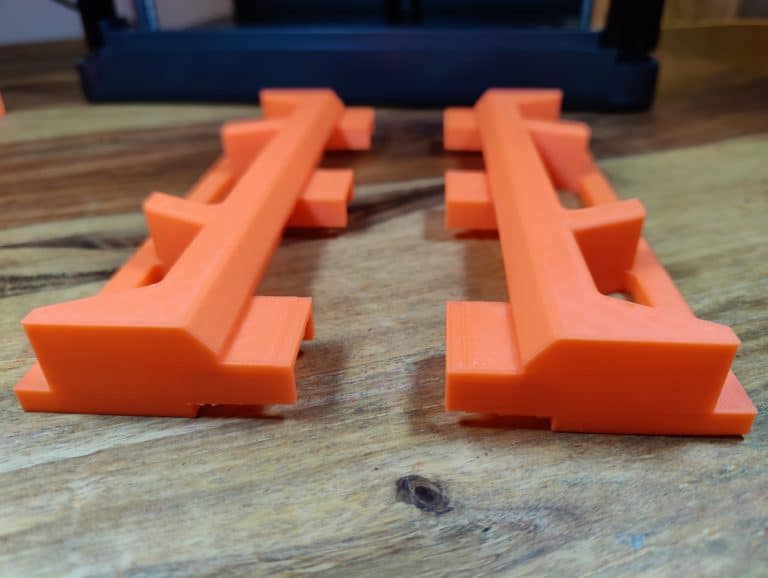
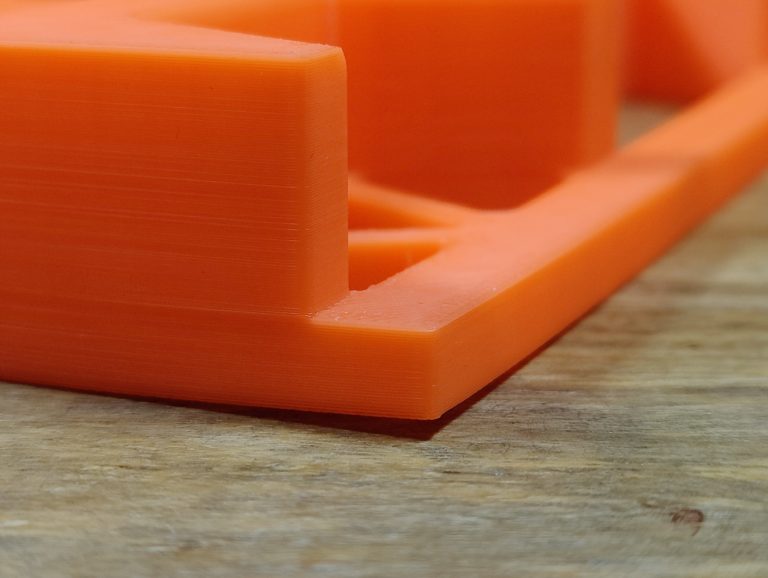
Bambu Lab – CG logo panels
Bambu Lab takes the individual design aspect seriously with the self-made side panels on both sides of the printer. Because unsolicited we have electronic mail with a design specially made for us: our own CG logo – whoop whoop! It is in 3mf format and this is where the aforementioned Bambu Lab Plate Management comes into play. 11 printing plates with a total printing time of easily more than 48 hours are waiting for me.
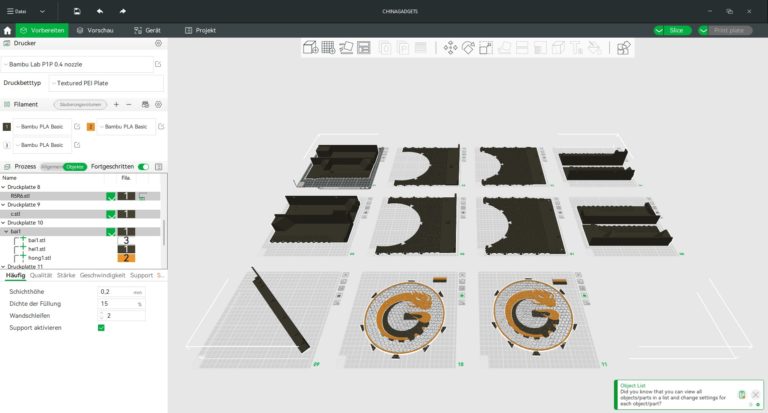
Bambu Lab has already stored all the parameters for the AMS, including the PLA colors black, orange and white . Because I don’t like my PLA orange that much, I switch to the well-known PETG orange and make a note of it in the slicer. Consequently, the nozzle temperature alternates between 220 and 250 degrees depending on the filament type.
I lower the bed temperature of 80 degrees, which is actually preset for PETG, to the 65 degrees used for PLA in order not to have a glass transition temperature problem. The results for the black printed parts – wall parts with a nice (time-consuming to print) triangular hole pattern – are really good.
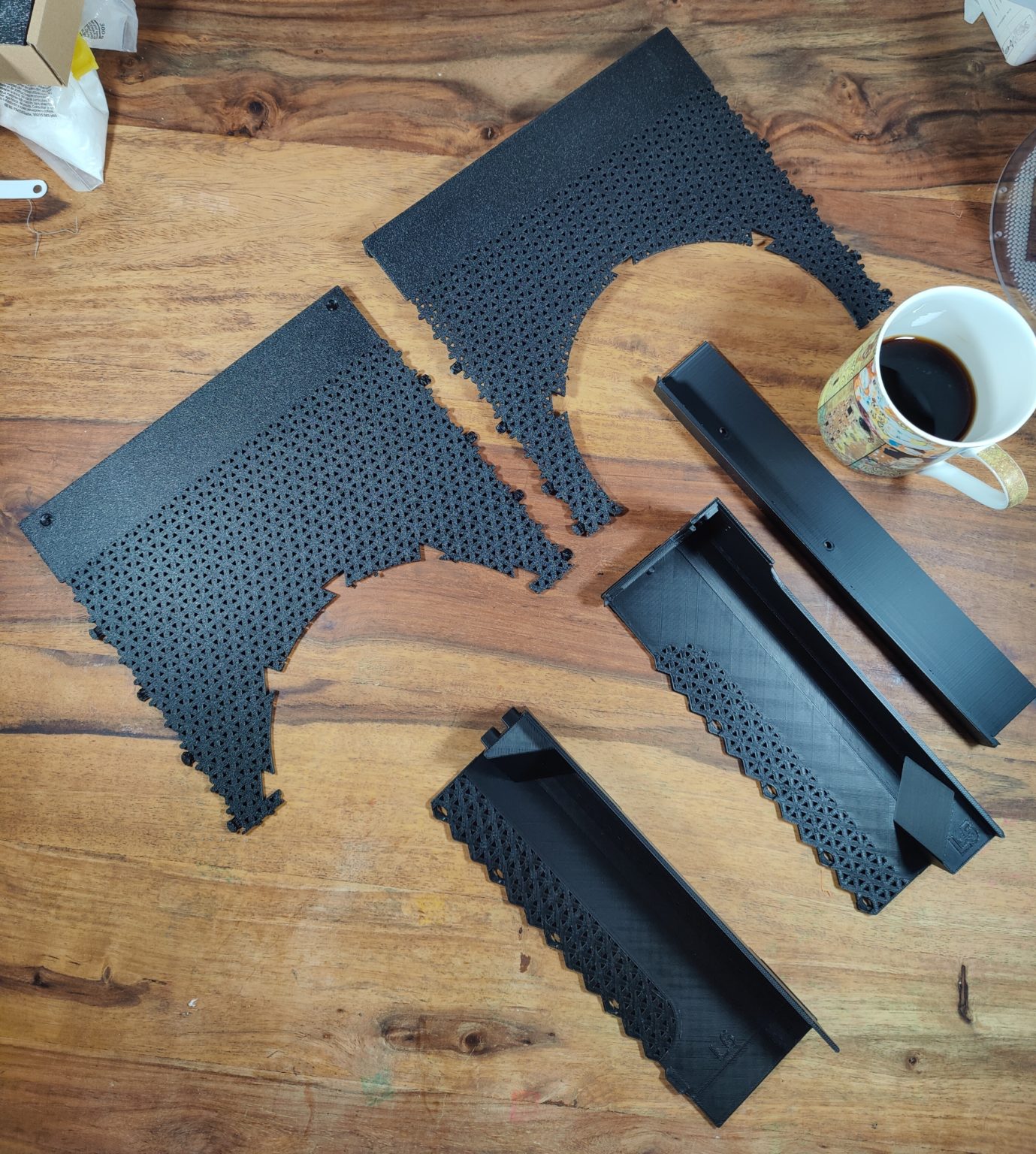
The hooks on the sides of these wall parts, from which you should then clip the side wall together, are less good. They and the holes in which they are to be anchored are far too filigree and Bambu Lab should have used better support here and chosen more generous tolerances. Some hooks were not printed or were only deformed due to missing supports. I have to help a lot with the cutter here to be able to put all the parts together reasonably accurately.
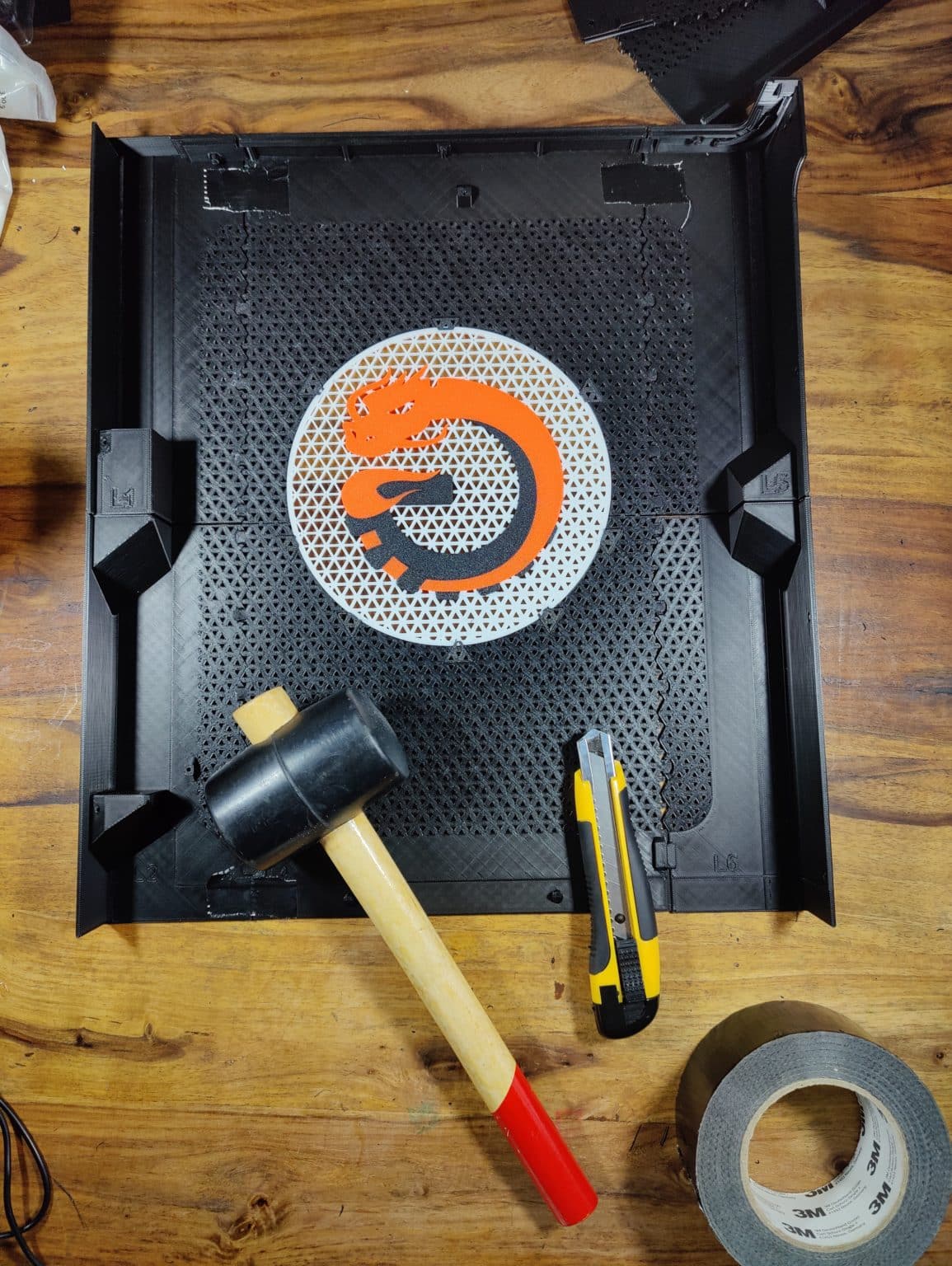
The actual CG logo is my first multi-color, multi-material print ever. Maybe that’s why I’m so excited about the end result. A minimal color error has crept in. In addition, the black PLA shows through in two places on the outer orange ring.
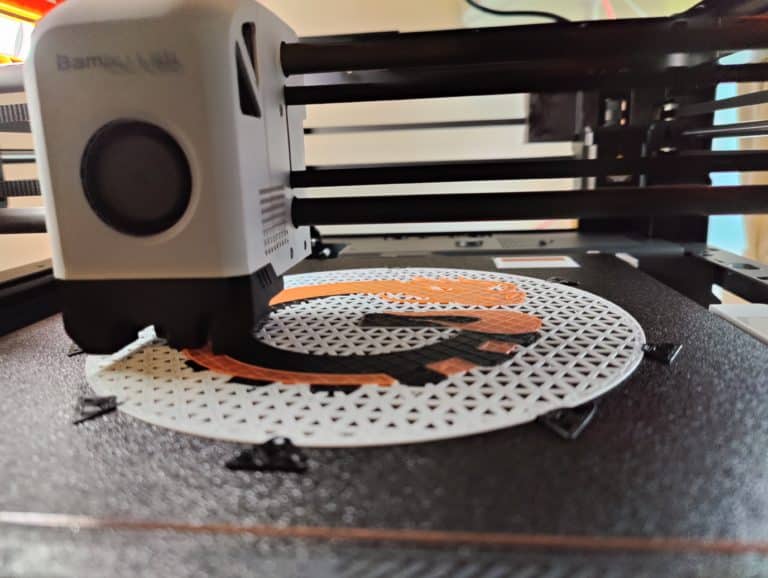
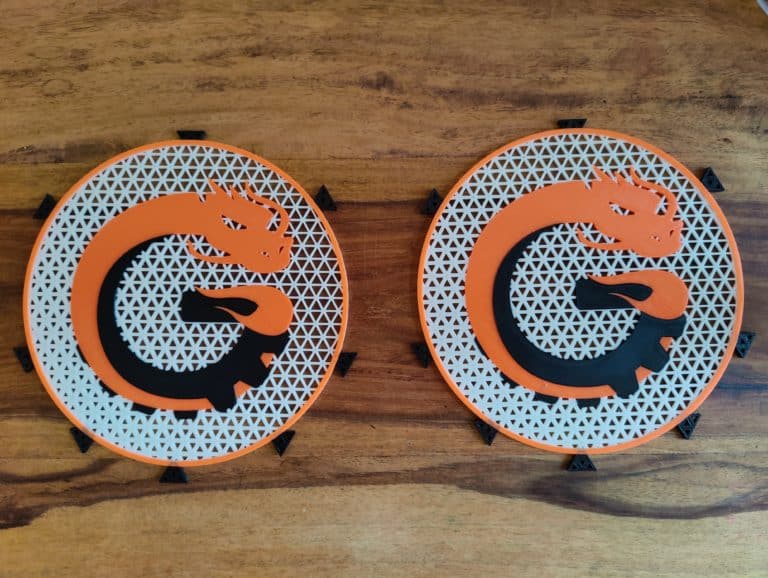
The still high level of waste production – i.e. the purge residues – is less impressive. coming out the back of the poop chute. Sure, there were 11 printing plates to be printed, but only 2 plates with multi-color printing. Judging by previous social media posts from other X1 owners, Bambu Lab has at least tweaked the material waste a bit here and improved it with the “Clean volume” option in the slicer to reduce waste. However, one has to take credit for the fact that only one print head and no IDEX system is available here.
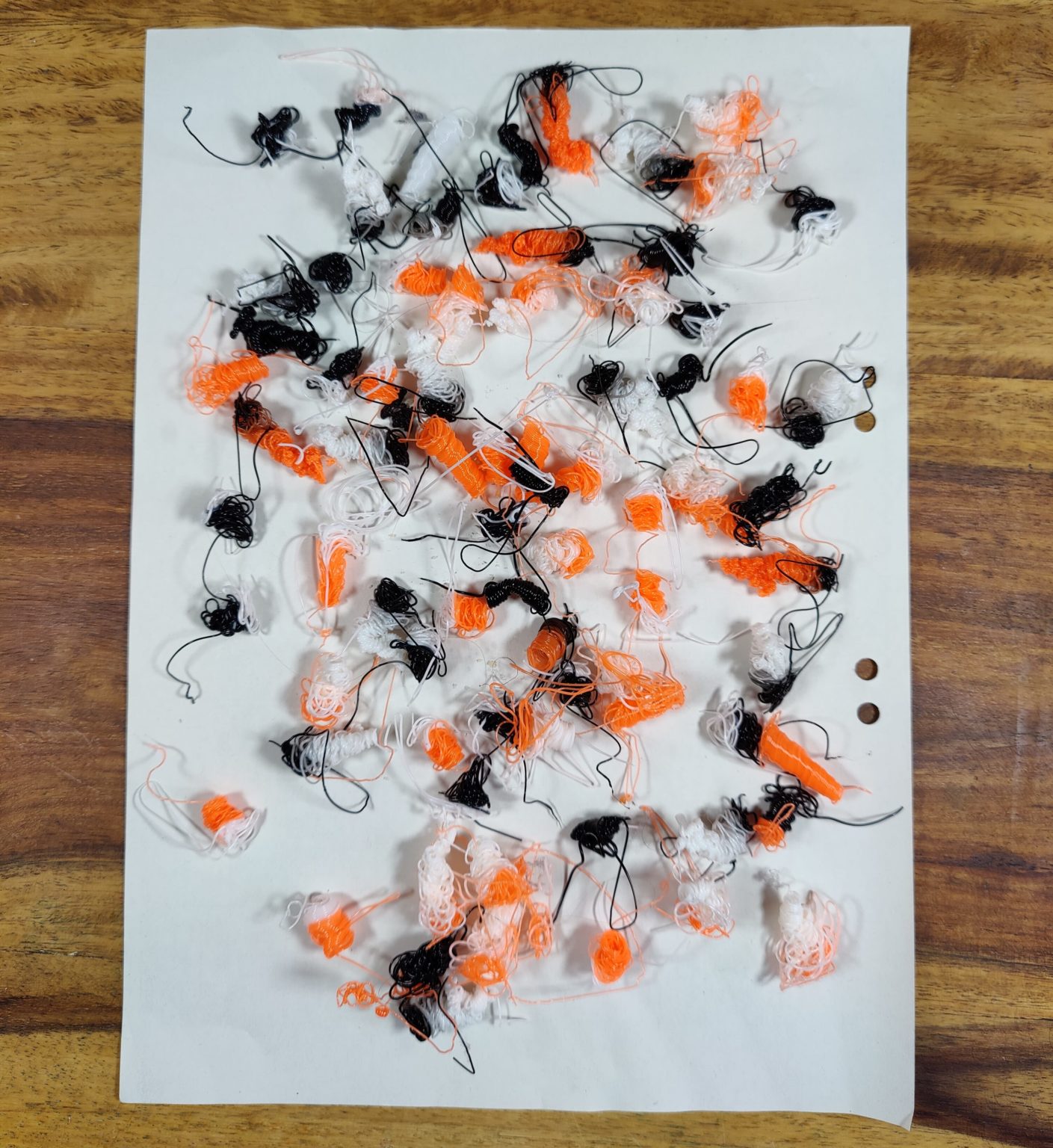
Actually, I want to start two more multi-color prints, but there are other prints waiting to be compared to the AnkerMake M5. I also want to stay under 7200 words and go on Christmas break starting tomorrow – but you will certainly see more prints with the AMS from the P1P or even the X1, don’t worry.
Voronoi Benchy
I use matte gray PLA filament next , because that really reveals every little flaw. Since this isn’t from Bambu Lab, I choose the Generic PLA profile in the slicer. At first glance, only the maximum volume velocity is reduced from 21 to 11 mm³/s. Because I also printed the Voronoi Benchy with the AnkerMake M5 in the default PLA settings , I am now doing the same with the Bambu Lab P1P. It then prints at 220°C to 65°C between 20 and 250mm/s and needs 01:29 hours for this. The result: sobering, see for yourself.
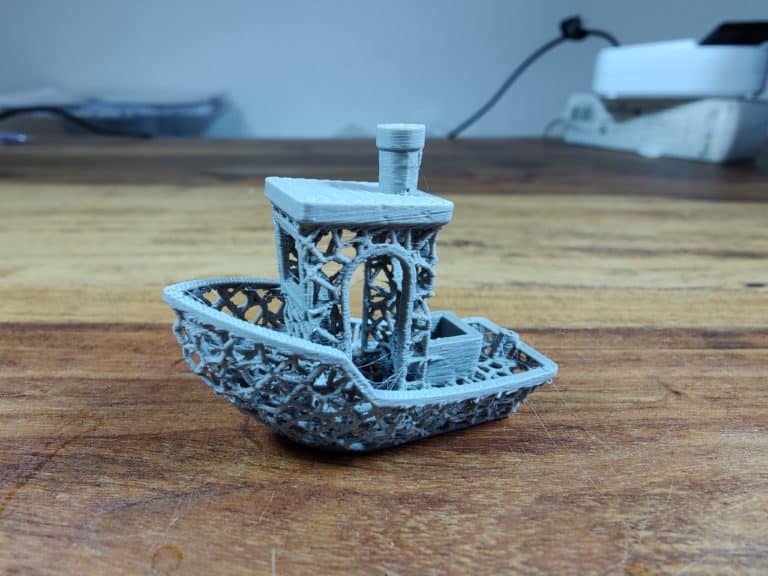
The printing temperature is too high and some holes (infill gaps) towards the walls cloud the overall picture. I don’t feel like a heat tower and start at 200°C to 60°C . Bingo! The Bambu Lab P1P likes Voronoi benches less than the AnkerMake M5. The second Voronoi bench looks better than the first though. Nevertheless, various imperfections remain in the print, for example some holes. Fine tuning in terms of infill overlap percentage, Z-seam and other top layers is definitely still necessary here.
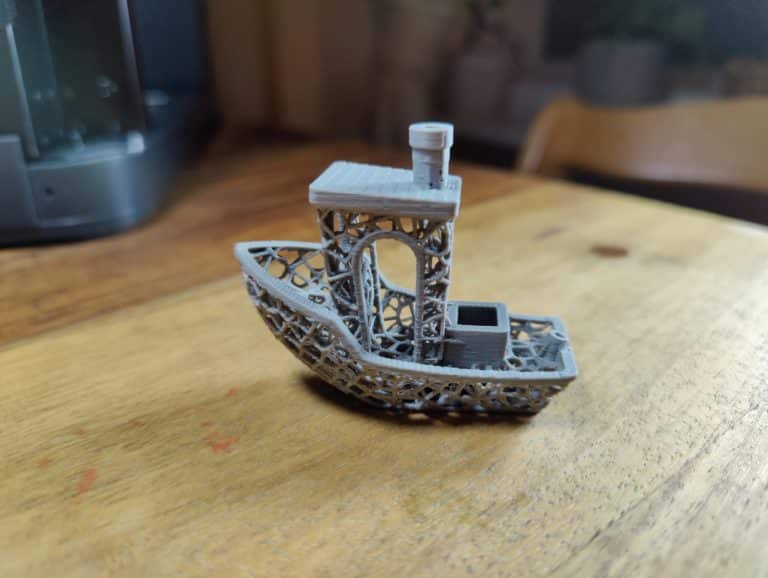
Fidget spinner
Yes, matte gray is the best way to see misprints, but that gets boring in the long run. For a change there’s matt blue PLA at also 200 to 60°C for another fidget spinner (things sell like hot cakes). A nice result after 44 minutes:
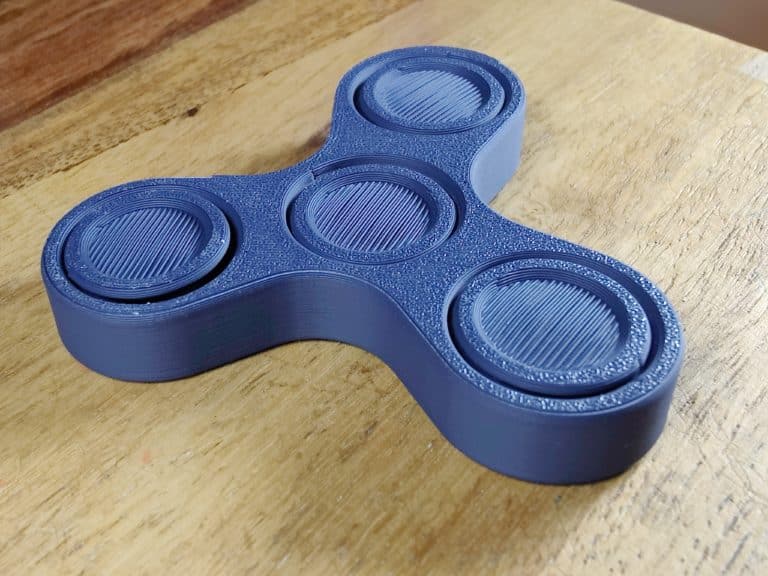
Mini all in one test
In this test, which, like the Voronoi bench, is not thrown away later in order to have comparison prints for all printers (#sustainability), matt gray PLA is again used at 200°C to 60°C . Significantly better after filigree mini columns with significantly less stringing overall.
Once again, fine tuning can get a lot out of this. 01:26 hours with speeds between 20 and 250mm/s, a mini all-in-one test comes out. Compared to the AnkerMake M5, the Bambu Lab P1P masters overhangs and bridging just as well, but has small imperfections in the outer skin and shows a clear horizontal bulge at the transition from the base area to the two overhang arches. But he succeeds in small details such as.
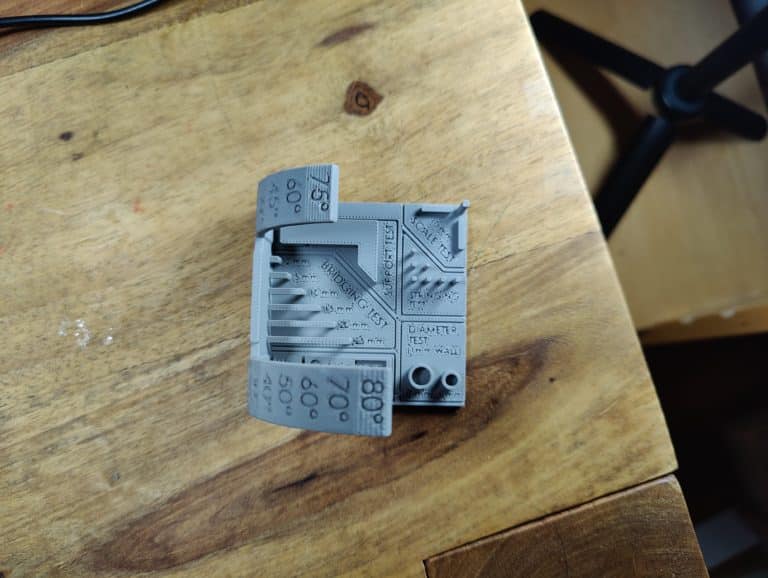

iMakr Jenga Cube
You may remember, I plan with the iMakr Jenga Calibration Cube You may remember that I am planning my own Jenga gameSo there still need to be a lot of blocks. Because such a bar can be printed quite quickly, I used it again this time in matt gray PLA ( 220° to 65°C) for a speed test. I print it in all four speed modes . It strikes me: At first glance, I can only change these modes during printing, a bit stupid but now good.
In standard mode (100%) – which is what I’ve always used so far – it prints the bar at a speed of between 50 and 270mm/s and takes 22:58 minutes. The result is okay out of the box except for warping at one corner , but again for not perfect due to smaller holes in the top layer.
A continuous horizontal offset line can be seen on the walls . In the silent mode (50%), on the other hand, the printing time is logically doubled. I can’t say whether the print speed range will also be halved. Live monitoring is missing here in terms of speed. The result is difficult to distinguish from standard mode. I even like the latter better!
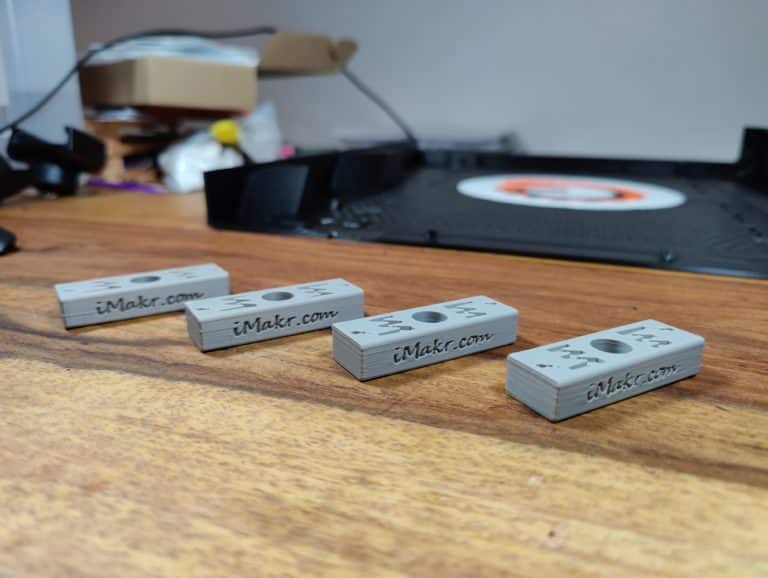
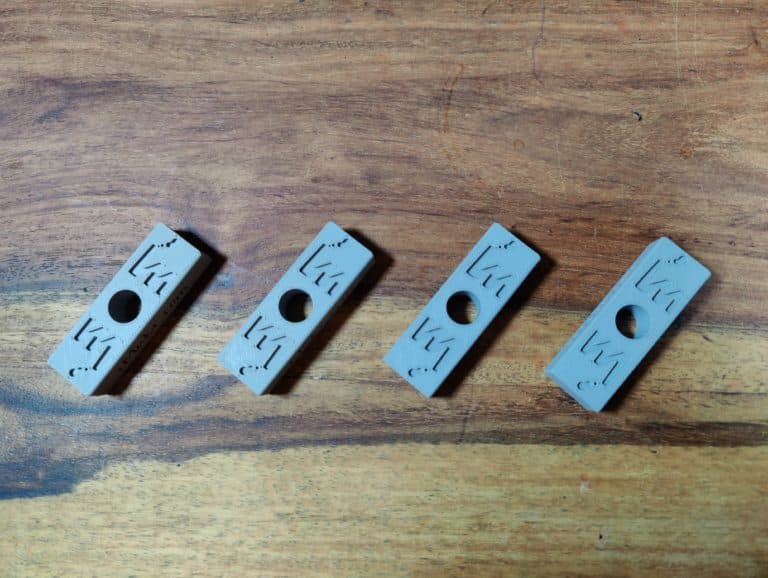
I find the sport mode (124%) even better , because in 18 minutes it prints the bar with the same, if not better, quality compared to the other modes, very cool! Finally, in the ludicrous mode (166%), the print head is somewhere between a speed trip (the drug) and an epileptic seizure: a fascinating spectacle and in any case great printer cinema. The result after 14 minutes (of which 6.5 for the start procedure) is simply great, apart from a slightly poorer top layer for simple prototypes – I’m really excited about what’s already possible out of the box. Here again – no time-lapse – the Ludicrous mode in action:
Own construction: To be continued
“Your ad could be here” – or Thommy’s own creations from Fusion 360. What are they? As a Dutch TV entertainer once said: let yourself be surprised!
Conclusion: Best 3D printer under 1000€
“Who are you more likely to save when our place is on fire: Bambu Lab or me?” my wife asks me, half smiling, half annoyed. I reply, “Stupid question…both of you, of course.” I’ll just leave out the order here. But hey, I really, really like this printer – and you can see that in these lines and in me as an otherwise (over)critical person who particularly appreciates open source à la Voron or RatRig.
Bambu Lab P1P Review definitely annoys the competition here, which of the 500mm/s CoreXY printer P1P should cause concern in the corresponding price segment . Compared to the X1, features such as the LIDAR sensor and NPU are not available, but the somewhat loud P1P with good prints out of the box doesn’t bother much.
On top of that, it cuts a fine figure as a DIY project by putting together your own individually designed side panels and a number of other upgrade options. Of course, it looks best with the CG logo. After this detailed test, all I can say is: Measured in terms of speed, Functionality and processing probably the best 3D printer under 1000€ to date on the test bench – congratulations, Bambu Lab!
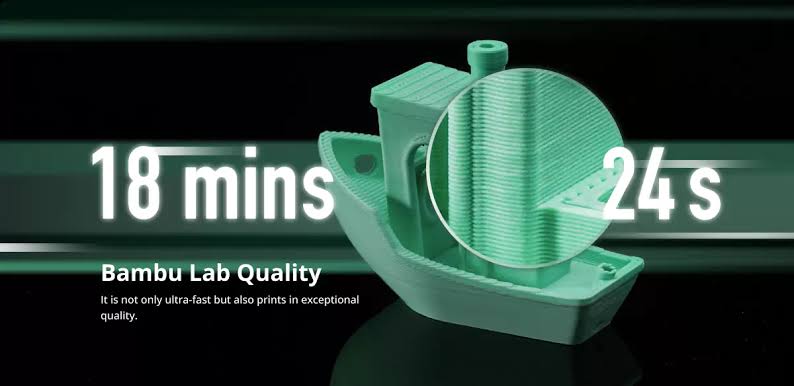
 Number One Boats from USA. Boat Marketplace Group Network. All Boats & Yachts for Sale, Reviews, Specs, Prices, Craigslists.
Number One Boats from USA. Boat Marketplace Group Network. All Boats & Yachts for Sale, Reviews, Specs, Prices, Craigslists. 